-521, 921 and 409 Bedford Articulated Lorry (1948-63) (cont...)
Greetings all!
Continuing with the series of changes to the Bedford Articulated Lorry, in particular, the changes to the prime mover, we move to February 1955, during which time, the model had changed its sales number from 521 to 921, a number series that denoted a DINKY SUPERTOYS - a designation that was in sales number only for the Bedford Articulated Lorry. The 921 Bedford Articulated Lorry was packaged in a newly designed box, a box that became known as "blue striped", having both the old and new sales numbers. The first model to be accommodated in this new style of box was the 25X Breakdown Lorry in February 1953. The next model was the new 582 Pullmore Car Transporter in April 1953 with the renumbered 521 Bedford Articulated Lorry to 921 in the same month, April 1953. It appears based on material available to me, when Meccano changed the sales number from 521 to 921 and gave the model a new "face-lifted" box it also changed the designation on the base plate from DINKY SUPERTOYS to DINKY TOYS.
921 BEDFORD ARTICULATED LORRY - QUALITY INSPECTED FEBRUARY 1955
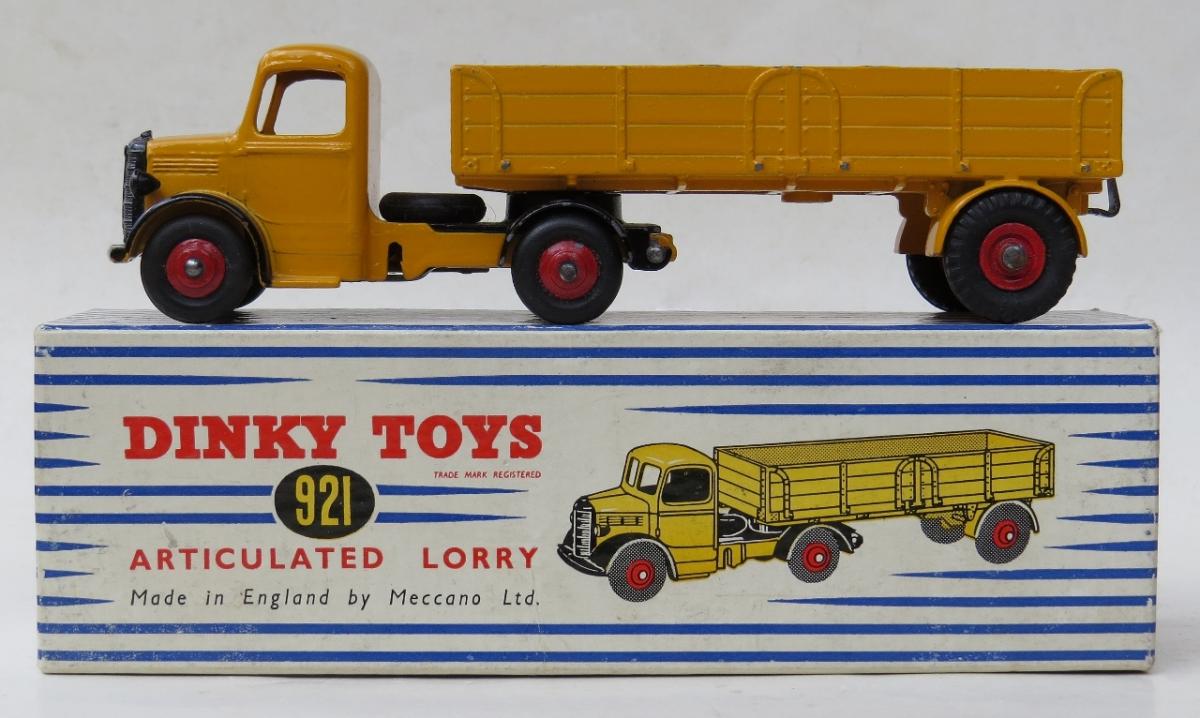
We now list the castings the 921 continued using as well as those that were changed. Numbers 2, 14, 27, 30 and 32 were constant since at least February 1953 with the only "new" change being to the petrol tank which apparently started to cause a great deal of trouble from April 1953.
2. Axle supports extended to lower bumper bar
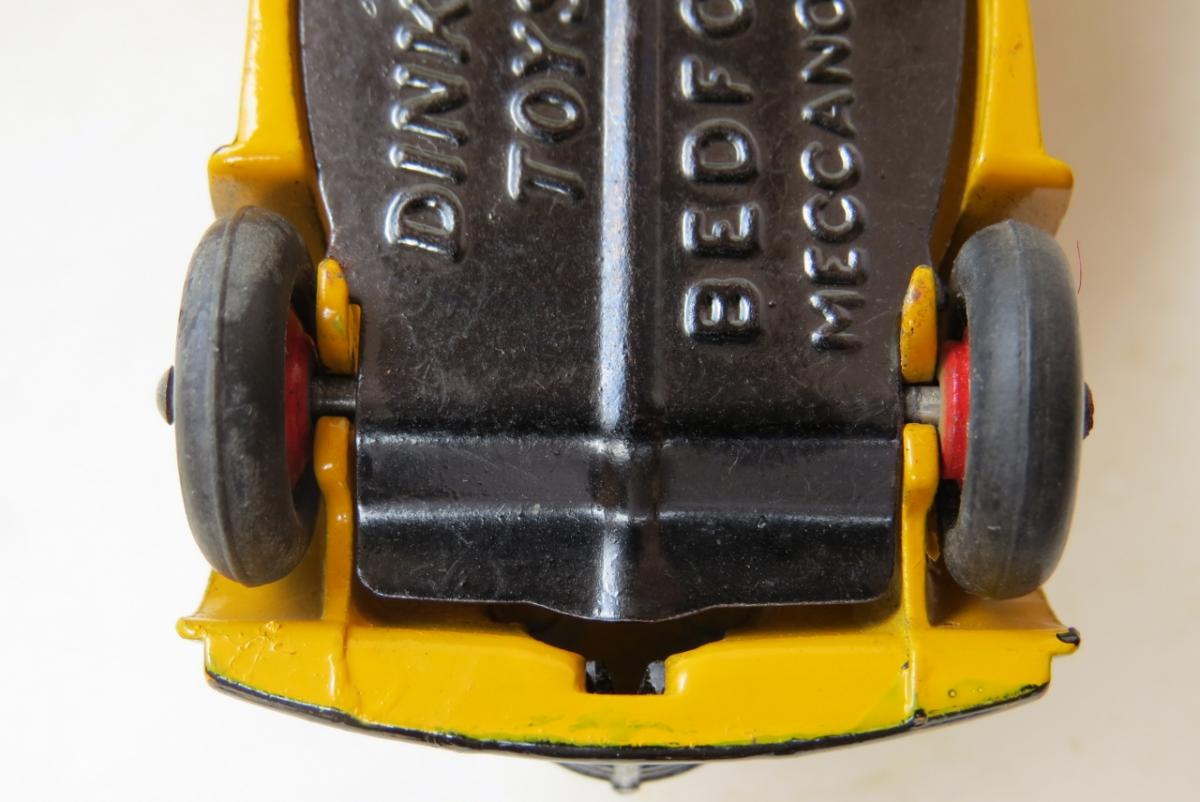
3. Chassis surrounding winding mechanism aperture flat
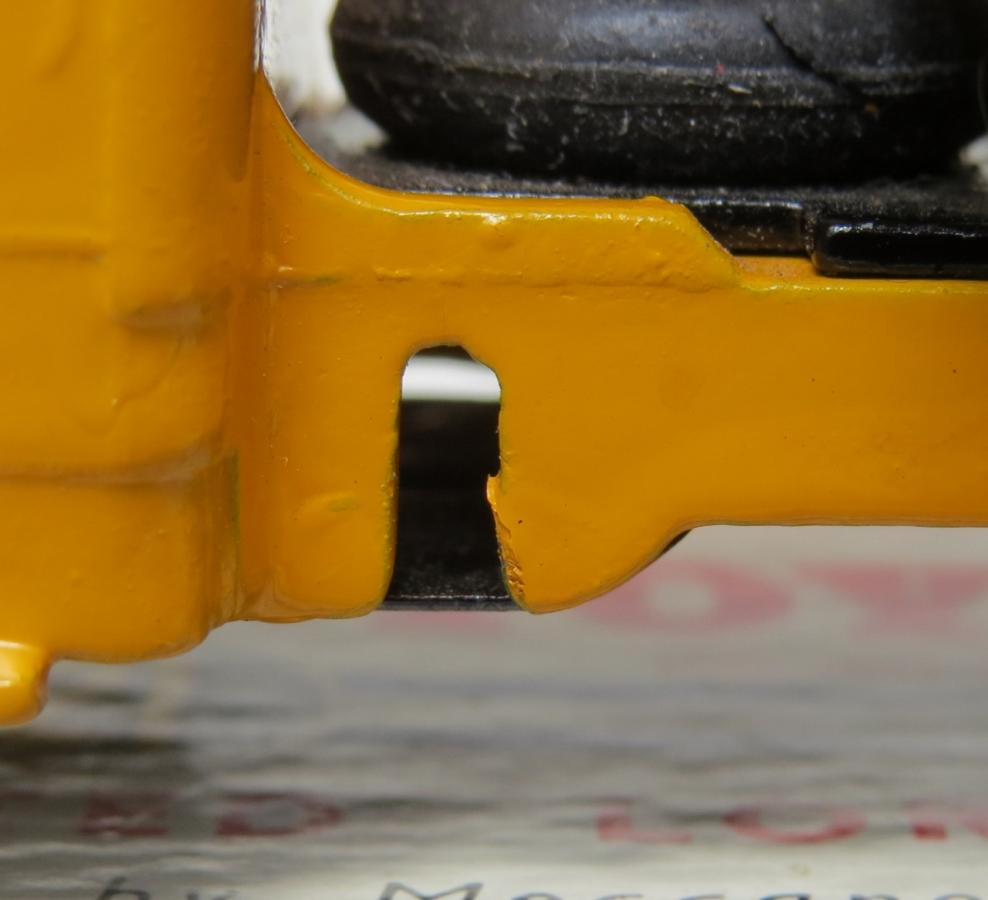
5A. Elongated-rounded lug above rear axle to keep wheel hub away from the chassis.
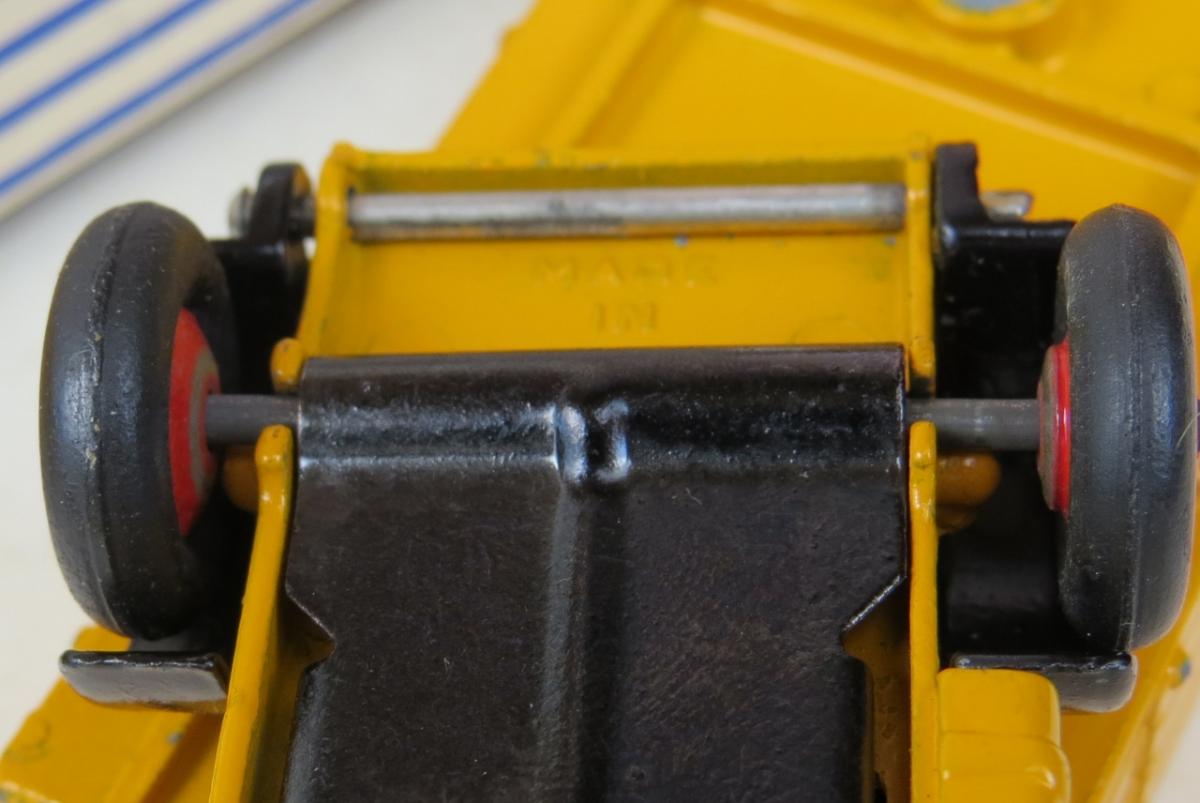
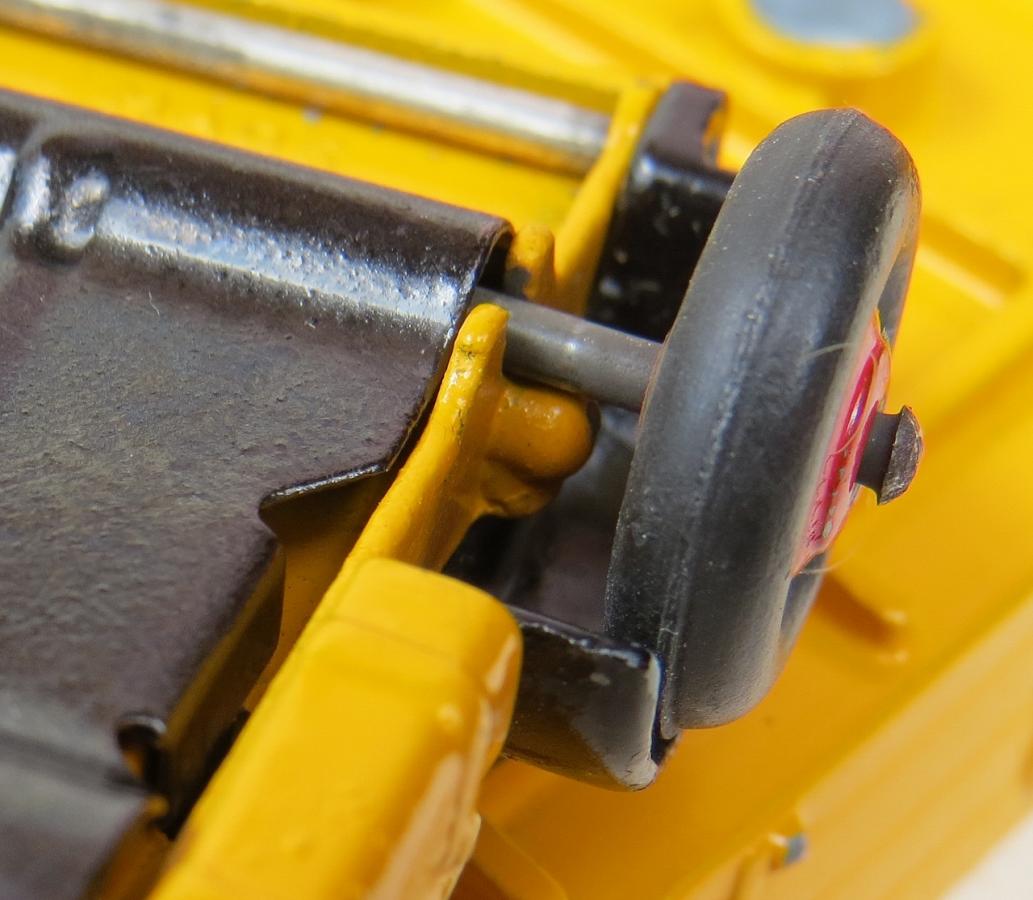
8. “Made in England” cast into flat area next to the pin holding the chassis to the platform
10b. Rectangular flat area covering 100% of the top of the petrol tank
From this in 1948:
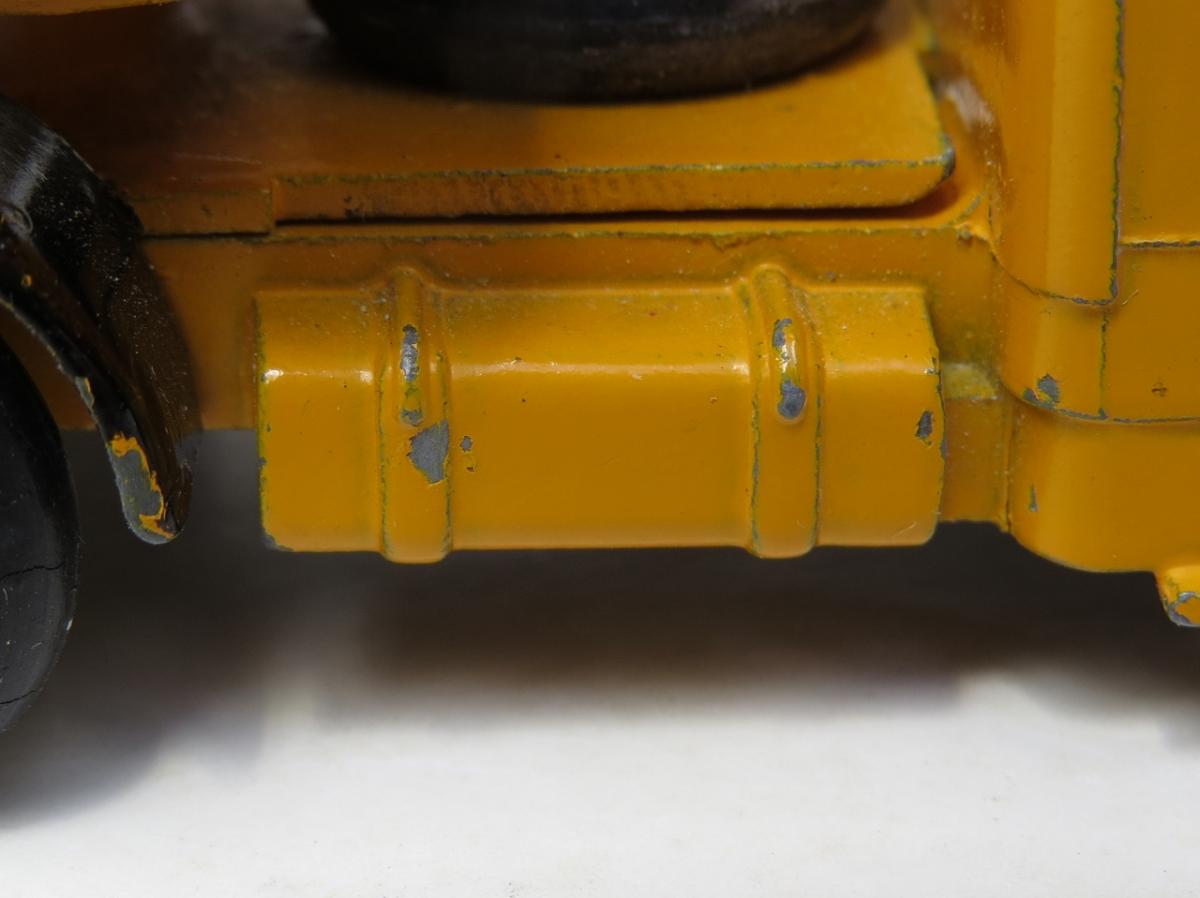
To this in 1955:
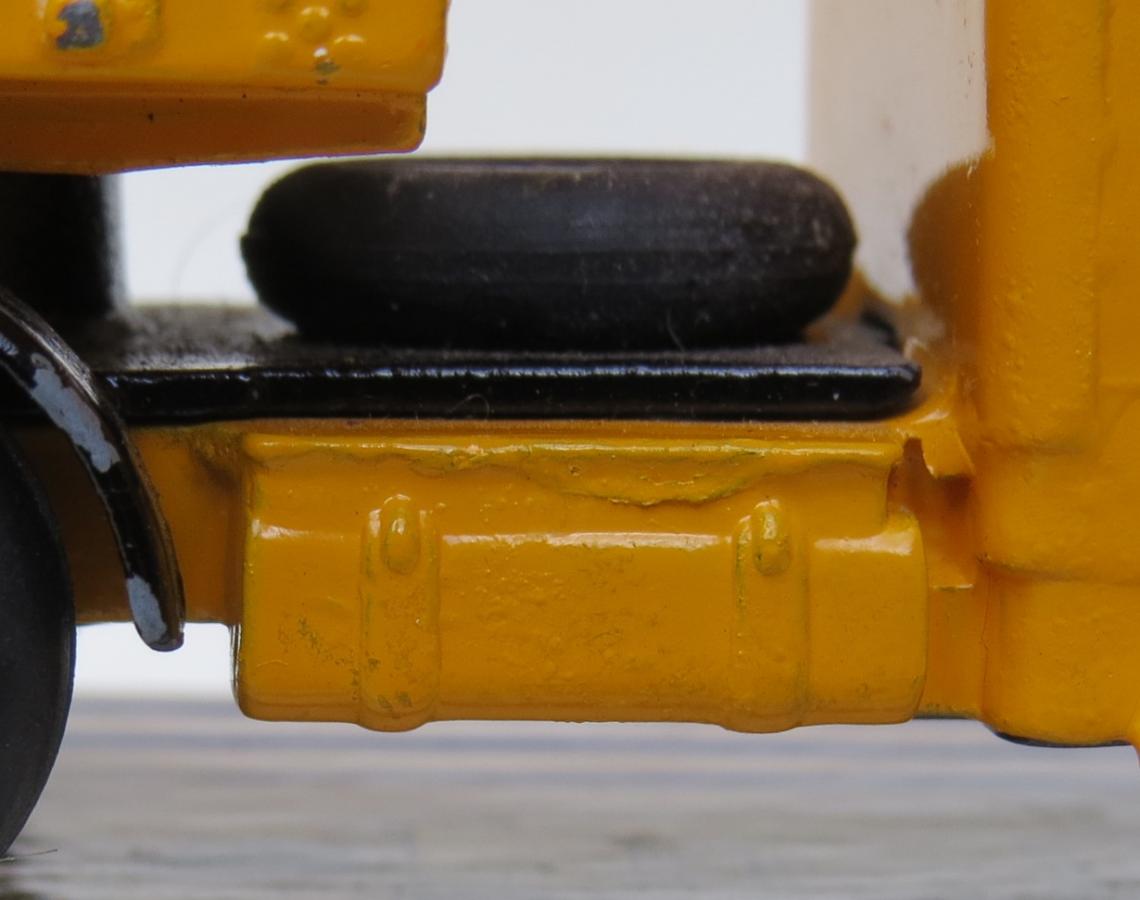
11. Curving chassis on either side of rear axle from the cab to the rear. This is only applicable with the Articulated.

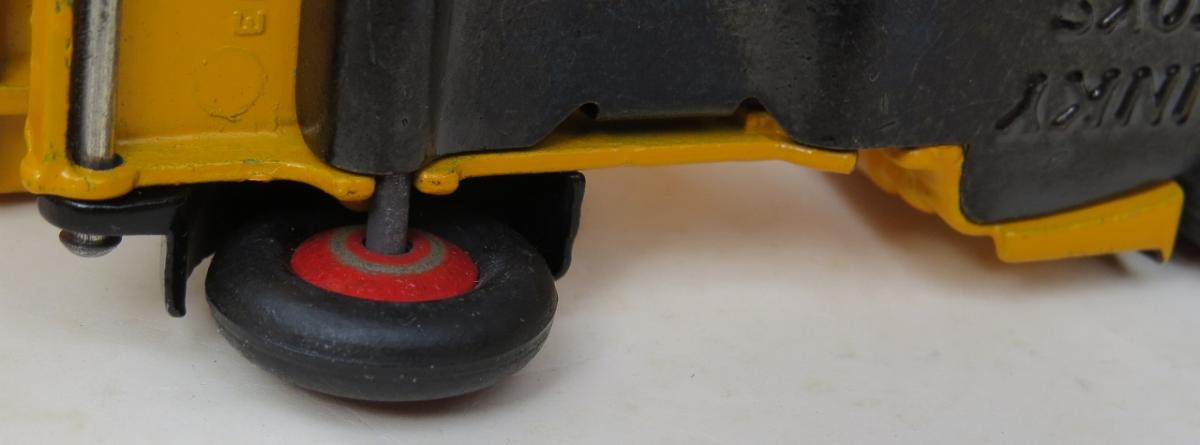
14. Casting ejector lugs more apparent closer to base plate, others below rear pin holding the model's non-hinged back less prominent.

15. Square-cut front mudguards
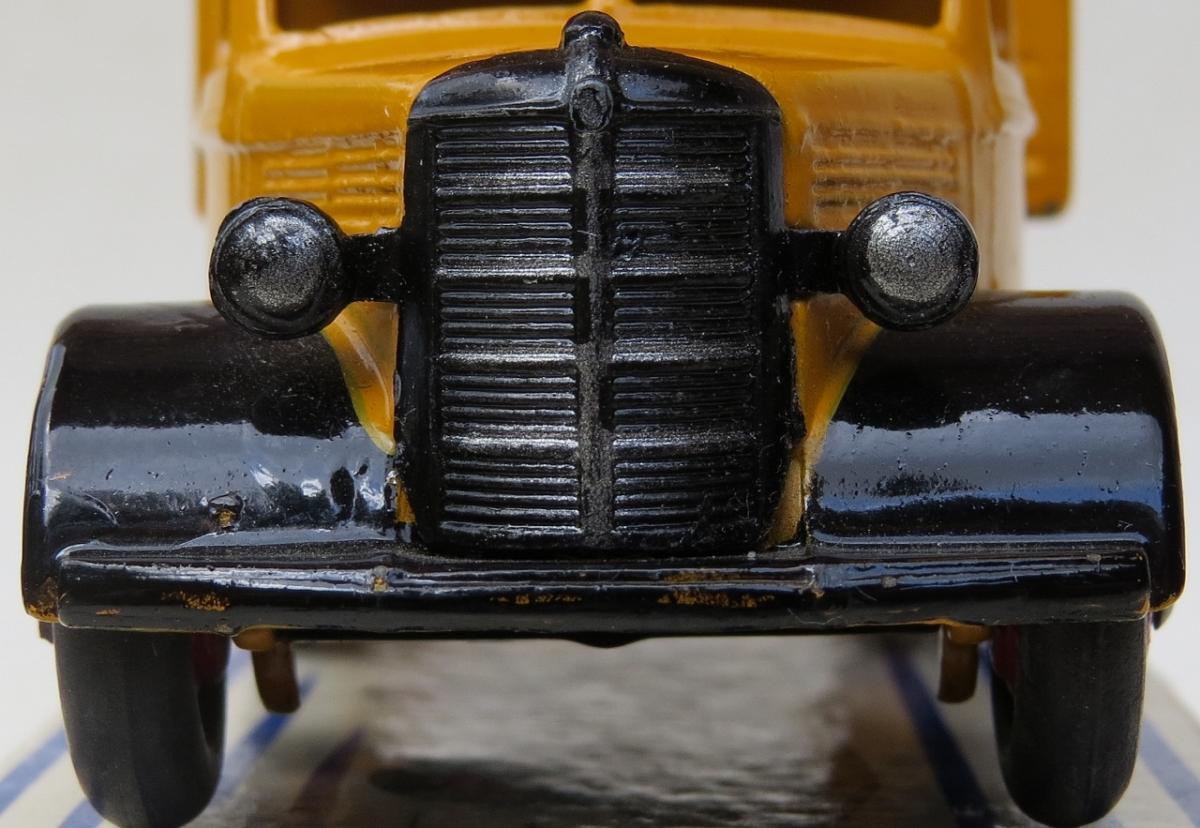
19. Chassis to cab above winding mechanism no longer straight angle now with added curvature to strengthen the casting

20. Rear mudguards in line with chassis
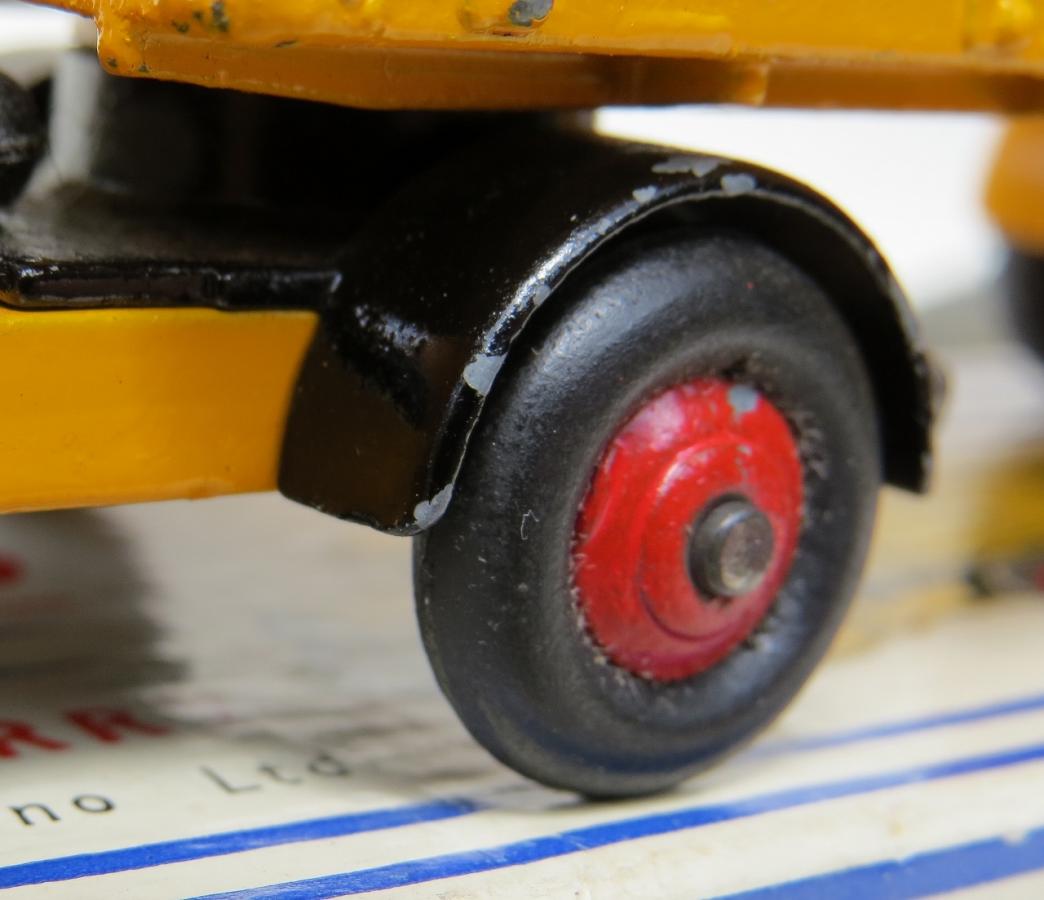
26.DINKY TOYS in large letters on base plate
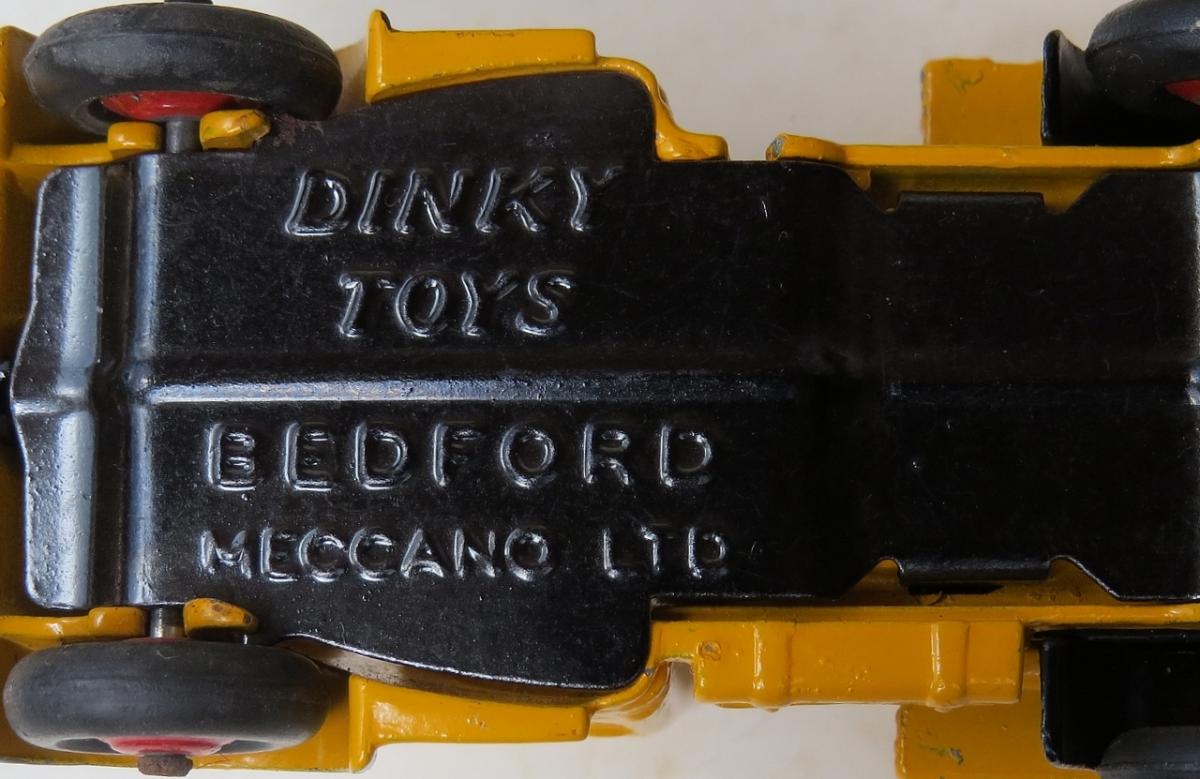
27. Rear body retaining pin rivet head at one end, crimped at the other

30. Large tow hook
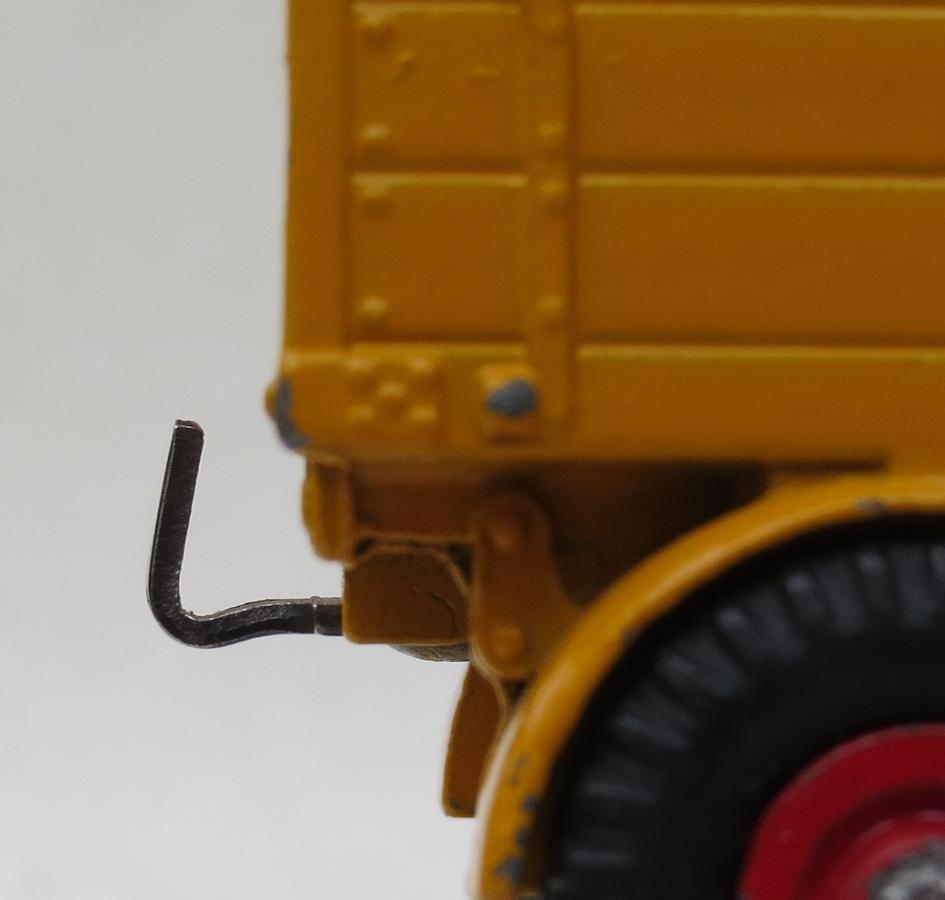
32. Trailer axle on 521 “closed”, a hole now drilled for axle, headed after insertion with hubs

Although some of the above casting numbers are a repeat of previous models, for the sake of continuity it has been decided to continue uploading images of each component for each model in case there are subtle differences.
Kind regards
Bruce H. (150)
20170316/1073:0035
Bruce--Superb documentation, photos, and descriptions on all these various changes that occurred over just a few years. An amazing example of Meccano reacting to issues or just improving the product.
Best regards, Terry
Having made some more photos of my new red example, I can share some with you, if you like, for the record.
So much has been written above already on this articulated truck, that these photos should suffice. Most characteristics, in terms of the criteria summed up above, are well visible. There is no 'Made in England' statement cast into the back base of the truck, Dinky Supertoys embossed in the base plate, and the rear wheel axle is fully supported. Remarkable that - deviating from most early examples - the semi-trailer is fitted with the same medium size tyres as on the truck, whereas most examples do have the large size DST tyres there until the mid-1950s. This is an example - though not mint - in unusual, wonderful condition, with a nice contemporary matching natural card box. The later yellow companion, which has been in the collection for over twenty years already, is a no. 409, with a quality control stamp B C 6 56 in its box lid. Kind regards, Jan
Jan..... Lovely example, and nice to see a red one; the yellow is so much more common, and the red looks very nice on it.
Jan, a very beautiful example and a very nice addition to your collection. The trailer of my red 521 2nd type also has the smaller smooth tires. The result is that the trailer at the rear is slightly lower than the tractor and the combination does not stand nicely horizontally on its wheels. This is clearly visible on my photo.
The trailer of my red 521 1st type has the larger grooved tires and the combination is therefore purely horizontal on its wheels. A red 521 1st type can be recognized through the purely 90 degree flat angle diecast strengthening on the left side behind the cab, while the 521 2nd type has a round diecast strengthening in the 90 degree angle left behind the cab. A 521-1 has an open trailer axle support while the 521-2 has a closed trailer axle support. Only the 521 type 1 has a turning stop in the casting for the tractor so that it cannot run all the way to the trailer. The later editions can.
Kind regards, Jan Oldenhuis, 1-12-2017
Jan, I know you like experimenting with the lighting and background of photos. Purely to show how I can change the exposure of this photo with a dark background and shadow with the lighting option (preset Brighten/Darken) in my photo program ACDSee Pro 6, so that you can now see through the model and the dark shadow disappears. I discovered this option a while ago and am using it to take away dark shadow.
Kind regards, Jan O.
Hi Jan, thank you for the feed back! I can imagine your suggestion. Sometimes it is a matter of taste, and also depending on the purpose what to choose for. My image may be slightly too dark indeed, which is more obvious in the small presentation than on the full presentation. With choosing this image I mainly tried to draw attention to the box. I work with Photoshop and some other image processing software, and the lighting option is always available. Your solution seems to introduce new distortion in colours etc. Well, the best I can offer you without disappointing myself is the image below. If I would have wished a lighter background I would probably have taken a more grey sheet of paper.
Always interesting stuff for discussion, much appreciated, Jan ! Kind regards, Jan W
Recently I received a very first version 521 Bedford Articulated Lorry with box in all-yellow with black mudguards and black hubs. It replaces my chipped research model I have sold. The Bedford Articulated Lorry is a very interesting model of which Bruce and I after research could make a list of 32 casting variations!! This model has already been shown in this topic, but I like to tell some additional details about this model, its box and its classification.
The very first versions were issued in 2 colour schemes, in all-red with black mudguards and black or red hubs and in all-yellow with black mudguards and black hubs. Only of these early versions the platform of the truck was painted in the colour of the body, while the truck's platform of the later versions are always painted black.
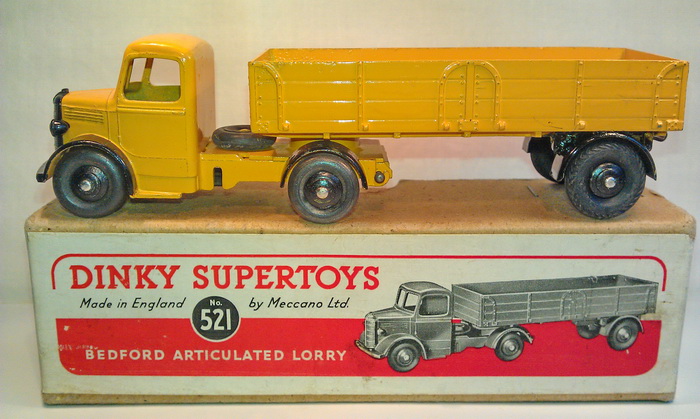
521 all-yellow with yellow truck platform
Stewart Orr & Graham Bridges were wrong when they stated in part II of Dinky Toys Bedford Trucks in Classis Toys, volume 2 issue 11 of May/June 1996: “On the early short-lived red versions the plate on the cab back that bolts the trailer is red with mudguards over sprayed in black, and when the yellow version appeared this plate is always black.” The earliest all-yellow versions definitely had the truck's platform painted yellow too, instead of black.
The first version is immediately recognizable by 3 characteristics and can only be found on the very first editions namely:
1) open trailer axle supports.
2) 90 degree right angle of the cab to the trailer platform on the left side without strengthening.
3) the truck cannot rotate all the way to the trailer, but has a ¾ rotate stop.
The trailer of my 521 is equipped with Herringbone tires, which I find very tough and attractive.
It's not easy to find this model in undamaged condition, but my model is in a very nice condition. It has a pristine 1st version brown cardboard lid box with red/white label and correct yellow colour dot that is often missing. The very clear red control stamp M48 (May?1948) is also present at the bottom of the box. It has a pencil price 6/9 on the box which is the price in Meccano price list of May 1948. It has all the special features that I would like to see on the model and box.

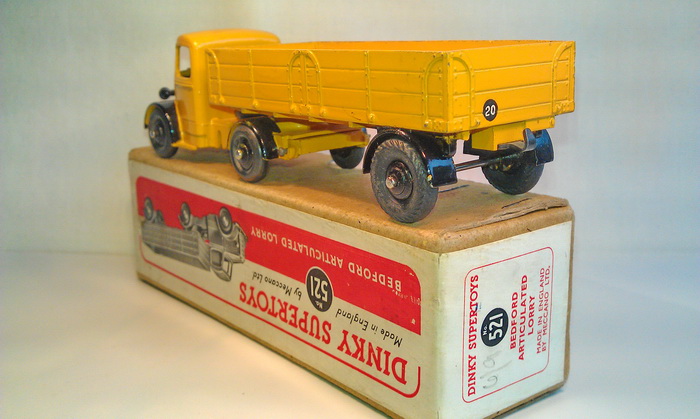
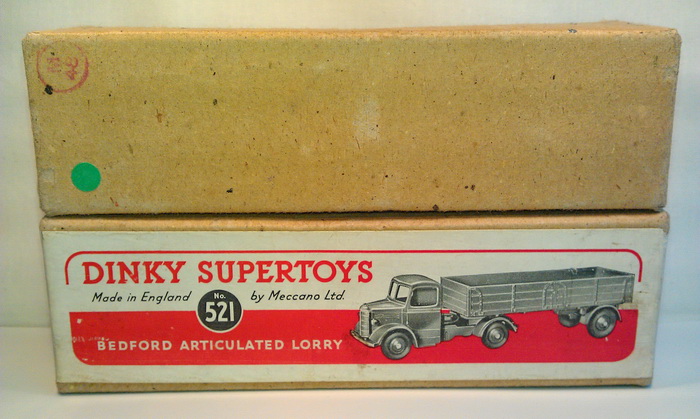
The sides of this type of cardboard boxes are always stapled, but the inner box always has one flap side without staples. This is done to prevent damage to the models body paintwork during transport. A model should always be transported on its side in the box and the top of the model should face the side without staples.
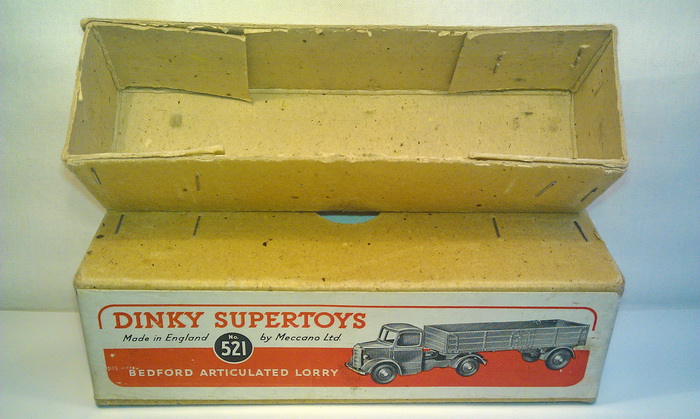

Sellers often pack the models incorrectly, which can cause damage. I always ask a seller to pack the model and box separately in a shipping box to avoid damage to the model as well as the box.
Meccano Liverpool’s struggle with the classification DINKY TOYS or DINKY SUPERTOYS:
There is something remarkable about the classification of the Bedford Trucks and 8 other Dinky Supertoys. An incomprehensible cumbersome reclassification operation (downgrading) took place of the 521 together with 8 other Dinky Supertoys to Dinky Toys.
From the beginning the box and the base of the 521 were marked as Dinky Supertoys, but Meccano Liverpool apparently struggled with the classification of the Dinky Supertoys in the renumbering era around 1953/1954. Sales number 521 changed to 921 and were marked Dinky Toys. Considering the Meccano Job list this was probably done on 14-1-53 where under number 6 states: Base was Job 12877. (That's my interpretation because I don't know what else it could be.)
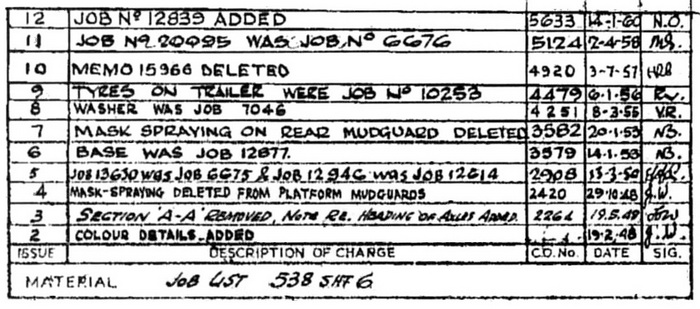
Detail Job List Bedford Articulated Lorry DTCA Jan Werner
Apparently it could not be solved well in one go, because the 921 number still belongs to the Supertoys range numbering 900 and sales number 921 had to be changed again in 1956 to 409 to become in the 400 commercial vehicles range numbering and to get the marking Dinky Toys from that time on.
According Cecil Gibson this reclassification took place in 1956 with 9 models: 511,512,513,521,522,531,532,533 and 551 and GBofDT also reports this in its tables. MM don't mention anything about it.
His brother 582 Bedford Pullmore Car Transporter went the same way in reverse. It started in 1953 with sales number 582 as Dinky Toys and got renumber 982, but still as a Dinky Toys. According announcement in MM of March 1955 the 982 model with 16 other models of the Dinky Toys range were re-classified (upgraded) as Dinky Supertoy and in 1956 it kept number 982, but were marked Dinky Supertoys from that time on.

MM March 1955
Incomprehensible that the management did not decide the right classification from the beginning of all its first designs. Meccano Liverpool apparently had no well thought-out standard criteria established for the Supertoys classification from the start and had to adjust this later on. This resulted in reclassification (downgrading) of 9 Dinky Supertoys to Dinky Toys and reclassification (upgrading) of 17 Dinky Toys models to Dinky Supertoys. A very surprising, but also a very confusing operation. We would like to know why this had to happen this way, but we will never find out.
Advertisements and publications with DINKY TOYS and DINKY SUPERTOYS classification:
From March 1951 till January 1955, Meccano Magazine advertised only with the Dinky Toys name. There was not a single advertisement with the Dinky Supertoys classification in 4 years!! It seemed like they wanted to quit the DINKY SUPERTOYS name.
In MM January 1955 the Toyman announces: “And I have one fine piece of news for you - the DINKY SUPERTOYS will return this year.” And in MM February: "As mentioned in the January MM, the name DINKY SUPERTOYS is being reintroduced for the largest models. These are listed below. New DINKY SUPERTOYS will be added during the next few months."
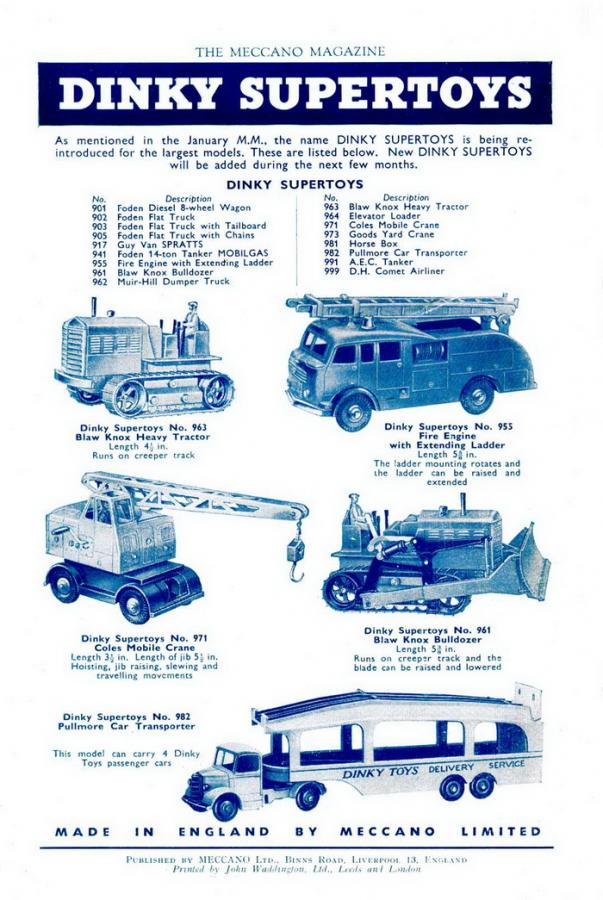
MM February 1955
From February and March 1955, the advertisements of Dinky Supertoys in MM resumed and the reclassification of 17 Dinky Toys to Dinky Supertoys were announced. In the subsequent advertisements, full attention was paid to these upgraded models, but the downgrading of 9 Dinky Supertoys to Dinky Toys were never published in MM.
In the following catalogues only Dinky Toys without Dinky Supertoys classification were issued: UK 1952 to 1954; USA 1953 and 1954; the Netherlands 1951 to 1954. The Meccano price lists UK had also no Supertoys classification from March 1951 to February 1955. Very strange, because In those times only in the store you could see if you bought a Dinky Toys or a Dinky Supertoys.
Failure to produce new Dinky Supertoys in that period could be due to metal shortages due to the Korean War, but that has nothing to do with the incomprehensible absence of a correct Dinky Supertoys classification in MM ads and DT catalogues. A very curious period in Dinky Toys history, prior to the renumbering process I described in the 27n 301 topic: http://www.dtcawebsite.com/forum-topic/27n-and-301-field-marshall-tractor-1953-66-and-process-renumbering
Jan Oldenhuis 28 April 2020
That is great, Jan! I happened to find mine only three months ago, the exact yellow brother of the red one on my photo. The only difference with yours seems to be the slightly later round tread of the tyres (and the differently coloured running board, compared with the red one). Congratulations and kind regards, Jan
Hi Jan, I cannot match your detailed scrutiny. ![]()
So here is an extra picture hopefully showing the details that you are curious of. I only see a difference in the rivets fixing the hooks, but you may see other. Also a scan of the box bottoms, showing the same quality control stamps as far as I'm aware. Kind regards, Jan
Jan. Thank you very much for the pictures. It confirms my suspicion of closed trailer axle supports. Indeed clear difference to see in the rivets. Mostly the convex rivets were used with this model, but I also have (had) several with these hollow rivets. Another difference can be seen in the rear pin holding the truck non-hinged back. The rear pin of your red one are both ends crimped. The rear pin of your yellow one is one end crimped, while the other end is rounded. These all-red and all-yellow coloured models complete with matching box are very special to have in your collection and very hard to find in this beautiful condition.
Kind regards, Jan O
Hello friends.
Here is my contrbution to this topic which is very dense with a lot of informations and details
So, I will just show my collection with three new informations : A white and blue box reference 409, the yellow model with glass and 2 bars on the left of the engine and 3 bars on the right side and 4 inscriptions variations on the truck.
Hello Richard. One thing continues to intrigue me when I see your overview photo of the Bedford Artics, but it can be optical illusion. That's why I'm asking you this. It seems as if the right Bedford Artic with yellow trailer mudguards does not have a reinforcement plate on top of the fuel tank, but this is not clearly visible on the photo. If it had no reinforcement on the fuel tank, I would find this very special, because the left Bedford Artic with black mudguards, which was previously issued, does have a reinforcement plate on the fuel tank. Has the right Bedford with yellow trailer mudguards a plate reinforcement on the fuel tank or not and does it have a Dinky Toys base plate? Kind regards, Jan.
1) On the model on the right, the base plate shows DINKY TOYS on the same line and "made in England" stamped on it.
2) The next one, DINKY TOYS is on two lines and "made in England" on the body.
3)On the third one, from the right, the base plate shows DINKY SUPERTOYS and "made in England" stamped on it.
4)The last one, on the left, has a baseplate showing DINKY SUPERTOYS but nowhere "made in England"
Kind regards
Richard
Richard. Congratulations on a very nice collection of Bedford artics, all of which have very interesting casting and colour variations. Very nice to search, find and show such variations. Certainly the red trailer with open axle is special. I am actually curious. Does that red truck also have a 3/4 rotation stop while the truck of later models can continue to rotate towards the trailer? See picture below.
The base plate number 4 (with Dinky Toys instead of Dinky Supertoys as you say by mistake) without made in England on the base plate or chassis is very special. I have not seen before.
It looks like factory base plate model number 1 should have been mounted on the truck number 4, because there is no Made in England on the chassis. I also have an example of an error in the factory of a base plate of which I show a photo.
The difference between the ventilation grilles on the left and right of the hood of the 409 with windows I think is more due to wear of the mold than a casting variation, but that is purely my own idea. All cabs of late 409 models have faint door contour lines and faint ventilation grilles compared to the earlier models.
Kind regards, Jan O
Hi Jan.
As soon as I read your message, i compare the rotations of my different models.
The results are :
My red models have not the same rotation angles ! (photo below) The model on the right is the one with the rear axle open fixation on the trailer.
Also, two yellow models with different rotation angles ! it is funny, is n't ?![]()
Kind regards
Richard
Richard, many thanks for your pictures. Yes, it is very funny to discover the differences when you compare them. I am actually now sure that only the trailer with an open axle has this rotation restriction of the truck and that is exactly what makes this very first 521 version so special and is nice to discover that. You can only discover this by comparing them.
Kind regards, Jan O
Jan, a very nice photo of the real Bedford Artic, now with a closed trailer. Your photo is very close to the Dinky Toys 521 early model. The fuel tank and the contour lines of the door and hood match well. The black mudguards and a different color for the cabin and trailer also stand out. For the fun, I made an amateur photo of this comparison with my mobile phone.
When you compare the semi-trailer wheels between the early and later ones, the early ones indeed are fitted with larger tires (21 mm). For example my late 409 with windows have all wheels the same tires (18 mm). As a result, the trailer doesn't seem to have the same horizontal height as the earlier with large tires, but the 409 slopes slightly towards the rear side. To achieve an equal horizontal height of the trailer, large tires for the trailer wheels are also required. For whatever reason, Meccano Liverpool apparently didn't consistently mount larger tires on the trailer wheels of any model. I post some photos of an early and late Bedford Artic to compare the trailer tires.
I take this opportunity to show Richard that my 409 with windows on the left side of the hood also has 2 bars in the ventilation grilles and 3 on the right.
Kind regards, Jan O.
On the photos of Jan W you can see how ingenious Meccano Liverpool has designed one basic chassis for the Bedford Truck, on which 5 different Bedford models are based. On Ebay I found a stripped 521 Bedford Artic and a 1st version 25m Bedford End Tipper where this is clearly visible. In the left corner of the platform to the cabin of the 521 you can already see a casting variation (reinforcement) compared to the flat angle of the 25m. If you look closely you will also see the yellow and orange lugs on the side of the platform chassis near the rear axle to keep the hub and tire off the chassis to prevent chafing. I haven't tried it myself yet, but I think it's quite easy to remove the base plate with coupling from the truck.
On the photo misses the 582 Pullmore Car Transporter, using the same basic chassis of the Bedford Truck. I found this stripped 582 Bedford Truck, also already with the reinforcement in the left corner of the platform to the cabin and the reinforcement of the fuel tank with a rectangular plate on the top. You clearly see the tabs of the baseplate fastened to the platform chassis of the truck. On Ebay I also found the coupling piece for the trailer that belongs to the 582 truck.
25v Bedford Refuse Wagon was produced the longest, until 1965 (17 years!!). These Bedfords were very popular and I think Meccano Liverpool cashed much money with them.
Meccano France produced in the same period and in the same way the 25 Series Studebaker (25o, 25k, 25l, 25m, 25p, 25q and 25r) and not to forget the very nice 25 Series Ford.
Kind regards, Jan O
Dear Bruce
I can not understand the following. Could you please explain what the differences are with the non artics and post comparative pictures ?
Kind regards
Jacques
11. Curving chassis on either side of rear axle from the cab to the rear. This is only applicable with the Articulated.
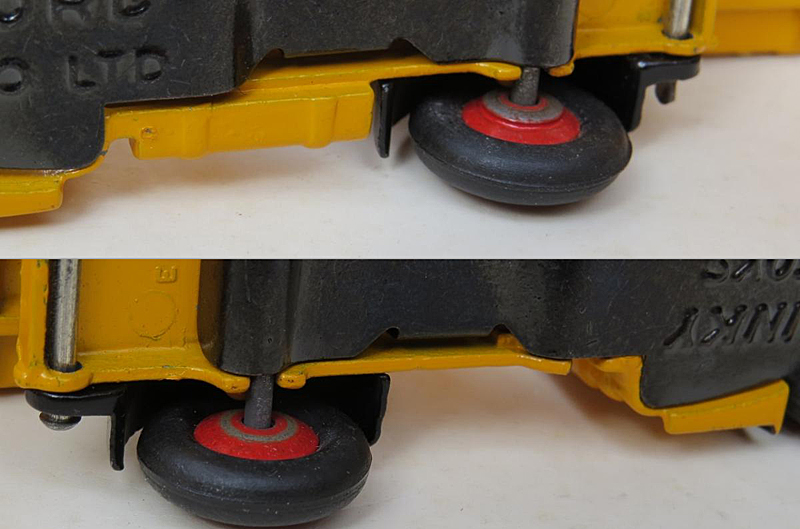
The Meccano drawings 12876 and 13630 give us a lot of information about changes and dates of changes. Now that we have been working on the details of the Bedford Artic for so long, I think I can explain these drawings.
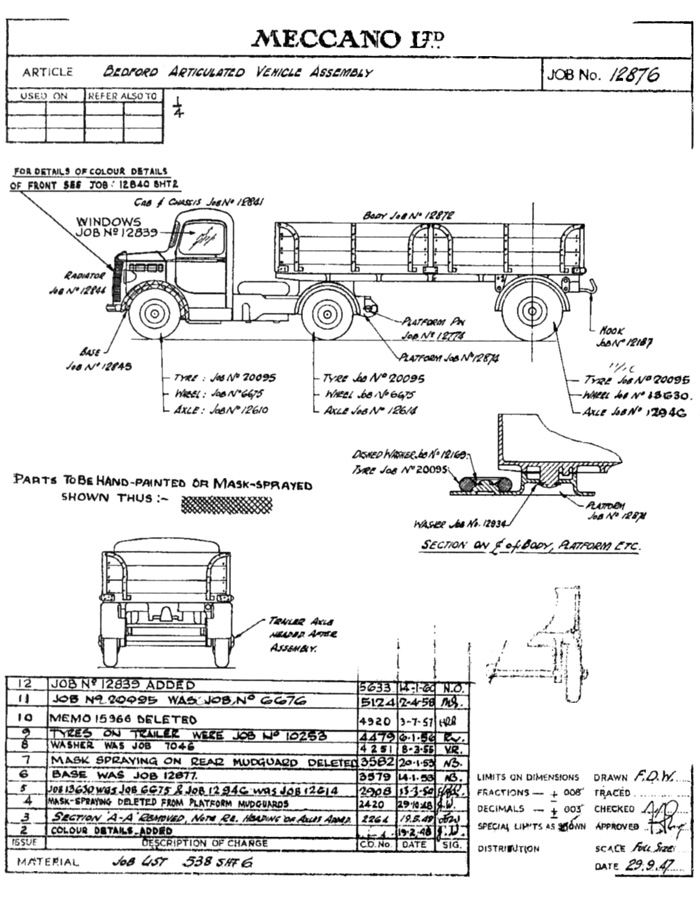
Job List 12876 of Jan Werner DTCA.
The Job list of the Meccano Bedford Artic assembly drawing 12876 lists 12 activities. A number of tasks have been discussed, but most of them have not. I don't pretent to be a specialist in reading drawings, but try to explain the details with my knowledge and ask members to respond.
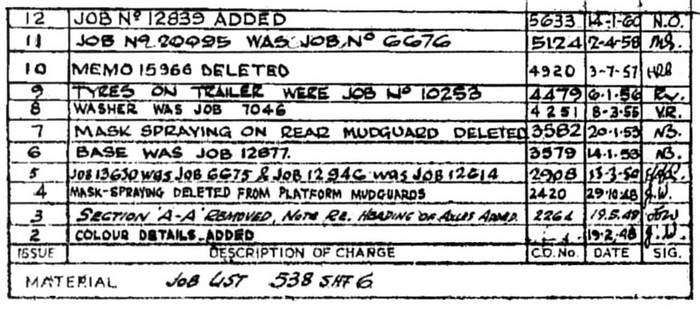
By comparing the job numbers of the drawing with the detailed job list, I can draw a certain conclusion with regard to the explanation thereof, which I compare with existing issued models. Documentation of articles, magazines, catalogues and auctions can also be helpful here.
*) Points 2 and 3: I have no explanation for these jobs.
*) Point 4: Mask-spraying deleted from platform mudguards, dated 29-10-48
The platform is clearly indicated by arrows on the drawing. I think this Job has to do with the platform, which were painted completely red or yellow at the beginning of production for the very first all red or all yellow version. But the rear mudguards also still had to be painted black by mask spraying. After the completely red and yellow version were ended, mask spraying of the rear mudguards could be stopped and the platform with the rear mudguards could be sprayed completely black now.
*) Point 5: Job 13630 was Job 6675 & Job 12946 was Job 12614, 13-3-50.
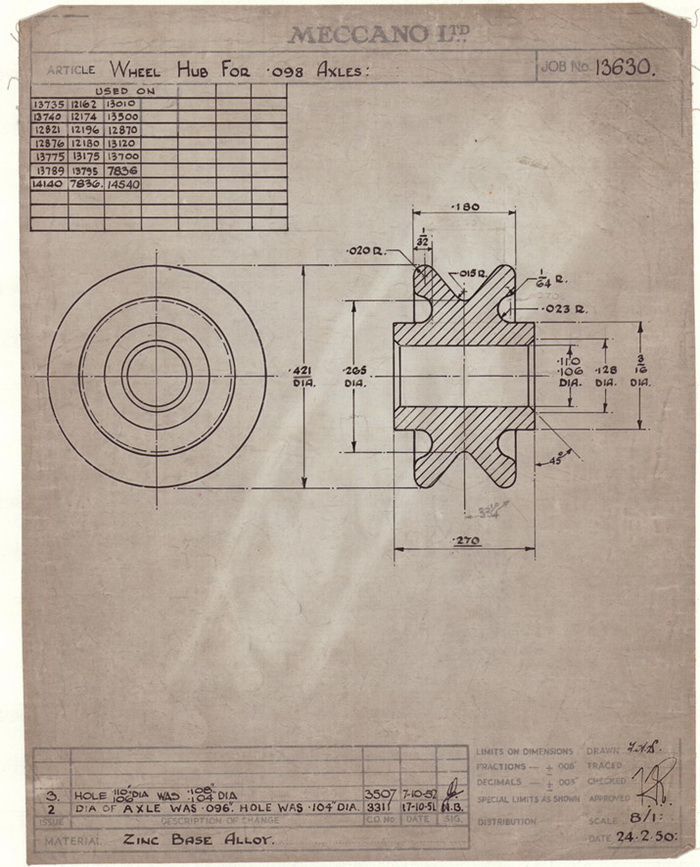
This is a very interesting Meccano drawing of Job 13630 Wheel Hub for .098 Axles posted by Andrew Lance under #9. When you compare it with the 12876 Bedford Artic assembly drawing you will see an arrow drawn to the rear wheel of the trailer stating "wheel Job No 13630”. I think this Job is the change from Ridged Hubs to Grooved Supertoy hubs. The Supertoy hubs needed larger holes for the thicker axle.
Under point 3 of Job 13630 it says "Hole 110/106 dia was 106/104 dia, dated 7-10-52. In the top left corner of the 13630 drawing you see a table with the title "used on". In that table Job 12876 is mentioned, being the Bedford Artic. In that table 12 Job numbers are entered, so this Job is applied on 12 models.
This means that the Supertoy hubs were mounted on the Bedford Artic trailer from 7-10-52 onwards.
*) Point 6: Base was Job 12677, dated 14-1-53.
In the assembly drawing 12876 you see an arrow on the front to the left wheel with the indication Base Job No 12845. Given the mention under point 6 "Base was Job 12677", dated 14-1-53, I explain that this new Job on 14-1-53 the Dinky Supertoys baseplate changed to Dinky Toys baseplate. I think this is also related to point 7 of the Job List, discussed below. You must keep in mind that the cab / chassis has its own Job No 12841, as shown in the drawing above the roof of the Bedford truck.
*) Point 7: Mask spraying on rear mudguard deleted, dated 20-1-53.
This Job refers to the rear mudguards of the trailer, which are no longer need painted black, but are now coloured yellow. This change is dated 20-1-53, almost simultaneously with the change from Dinky Supertoys to Dinky Toys base plate on 14-1-53. I think this was done to give this Bedford Artic its own Dinky Toys appearance to distinguish from a Dinky Supertoys. Points 6 and 7 were initialled by the same person.
Below you can see the picture of 521 in the 1952 catalogue with black mudguards and ridged hubs on the trailer rear wheels compared to an existing issued model 521. In the 1953 catalogue below you can already see the 521 with yellow mudguards and grooved Supertoys hubs on the trailer rear wheels compared to an existing issued model 521-921.
This is proof that the change from Dinky Supertoys to Dinky Toys baseplate and from ridged hubs to Supertoy hubs for the Bedford Artic took place as early as 1953, rather than 1954, as is commonly stated.

1952 UK catalogue - 521 trailer with black mudguards and ridged hubs.

521 trailer with black mudguards and ridged hubs.
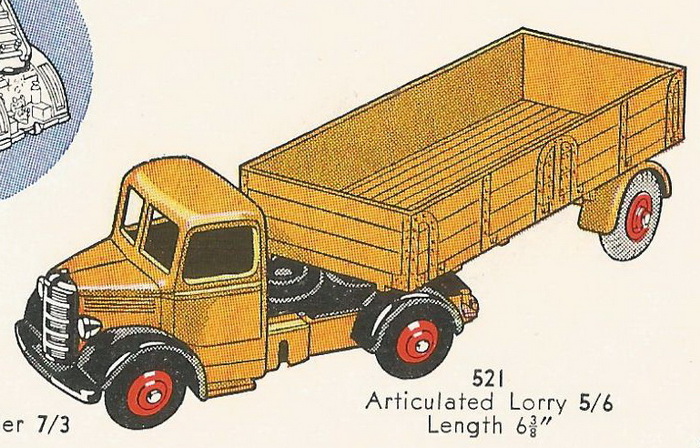
1953 UK catalogue - 521 trailer with yellow mudguards and Supertoy hubs.

My 921- 521 trailer with yellow mudguards en Supertoy hubs.
*) Point 8: Washer was Job 7046, dated 8-3-55.
Above the section on Body, Platform etc. you see an arrow to the platform link with the mention Washer Job No 12934.
This Job refers to the washer inside the platform coupling, which is not visible.
*) Point 9: Tyres on trailer were Job No 10253, dated 6-1-56.
On the 12876 assembly drawing you see an arrow on all wheels with the mention "Tyre Job No 20095". This is a different number from Job No 10253 of point 9. What we now know from the practice of the issued 409 models is that on the Artic models from 1956 to 1958, when Dinky Toys 921 changed to 409, all wheels were fitted with smooth tyres with the same size. We also see this in the images in the catalogues. After this, the tyres once again changed in point 11, with the same size for all wheels. So we can conclude that from 1956 onwards, no more larger tyres were mounted on the rear wheels of the trailer.

1957 UK catalogue: 409 with smooth tyres of the same size on all wheels
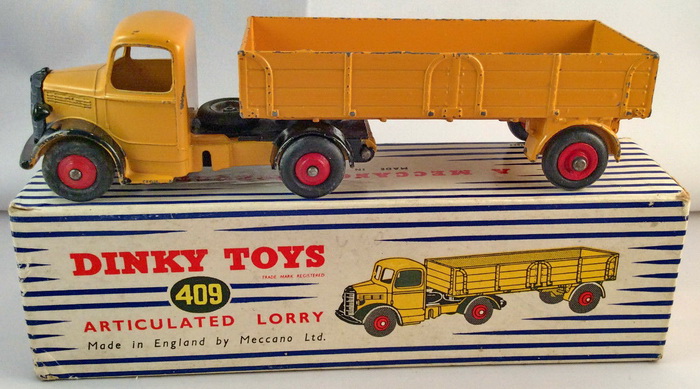
409 with smooth tyres of the same size on all wheels – 1956-1958.
*) Point 10: Memo 15966 deleted, dated 3-7-57.
I don’t know this memo and have no explanation for this Job.
*) Point 11: Job No 20095 was Job No 6676, dated 2-4-58.
As point 9. On the assembly drawing, all wheels have the same Tyre Job No 20095, which means that all wheels have the same tyre with the same size. As you can see on the cut out drawing of the truck platform for the trailer, the spare wheel on the platform has also the same Tyre Job 20095.
So no more larger tyres on the rear wheels of the trailer from 1956 onwards.
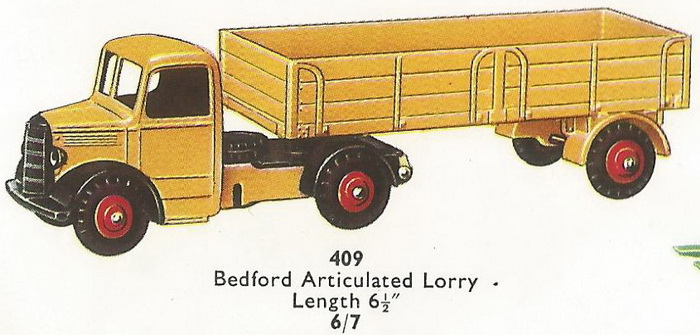
1960 catalogue: 409 Bedford Articulated Lorry with knobbly tyres of the same size. Even the spare wheel on the platform has this tyre.
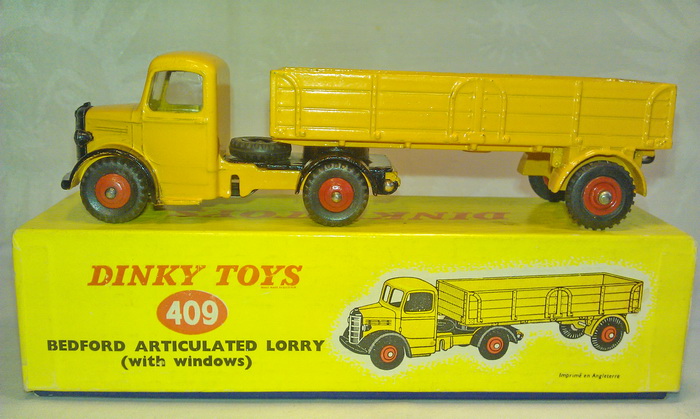
1960: My 409 Bedford Articulated Lorry with knobbly tyres of the same size ( 18 mm) on all wheels. Even the spare wheel on the platform has this tyre.
*) Point 12: Job No 12839 added, dated 14-1-60.
On the assembly drawing you see an arrow to the windows of the Artic with the mention "Windows Job No 12839", meaning that from 14-1-60 onwards the Bedford Artic got plastic windows.
Note: To substantiate my statement about the changing of the baseplate from Dinky Supertoys to Dinky Toys on 14-1-53, I started examining whether the base plates of Bedford Artics with yellow trailer mudguards always have a Dinky Toys base plate.
Till now I have not yet found a Bedford Artic with yellow trailer mudguards that has a Dinky Supertoys base plate. If this will be found, I would like to see a photo of it in this Topic. Likewise, if a Bedford Artic with black trailer mudguards is found with a Dinky Toys base plate, I would like to see a photo of it here in the forum.
Jan Oldenhuis, 6 July 2020.
Dear Jan,
Many thanks for this great revue of the drawing 12 876.
I can add two little things :
The memo 15 966 (your point 10) refers to the 20 mph. speed limit transfer.
The models listed on the Supertoys wheel hub drawing are :
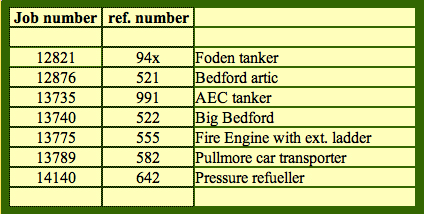
Have you noticed that in your Encyclopaedia in the right hand menu of the home page is a list of about 1600 job numbers. This may be usefull for your research.
Jacques and Jan W, thank you for your valuable addition. Jacques, I had not yet seen the Jobs list in your encyclopedia menu and have now started looking at it. Very valuable information. I'm going to take a closer look at that now.
Kind regards, Jan O
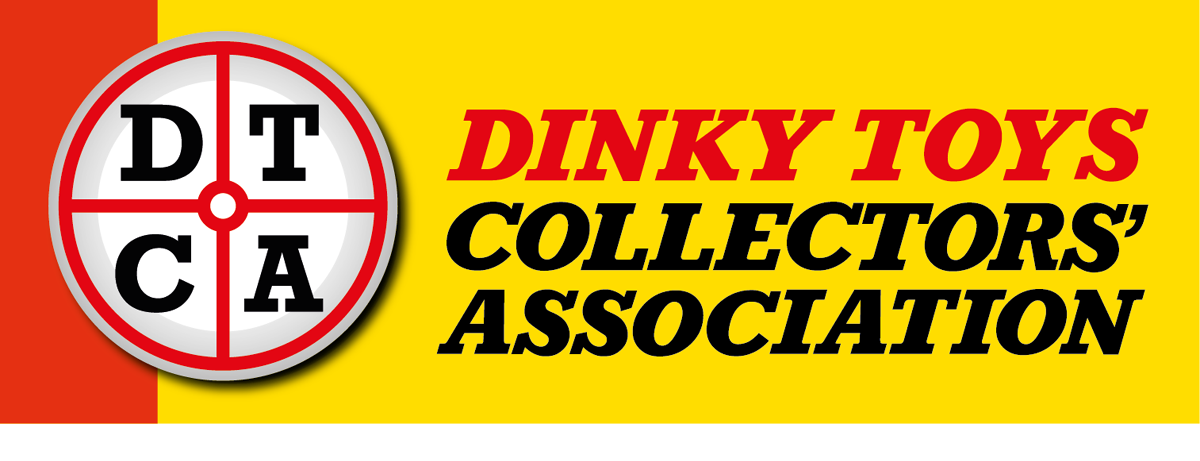

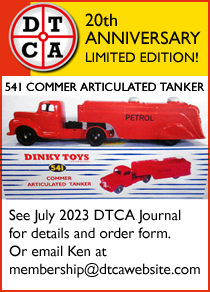

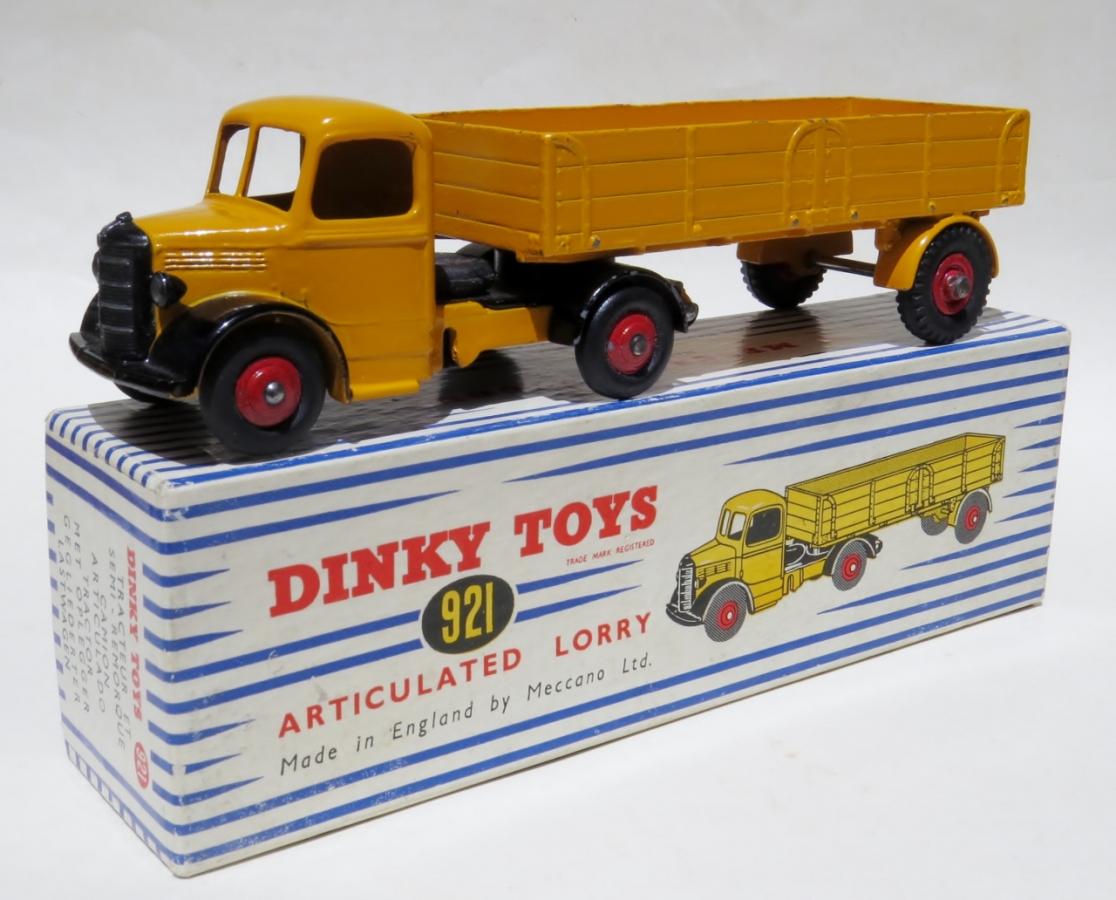


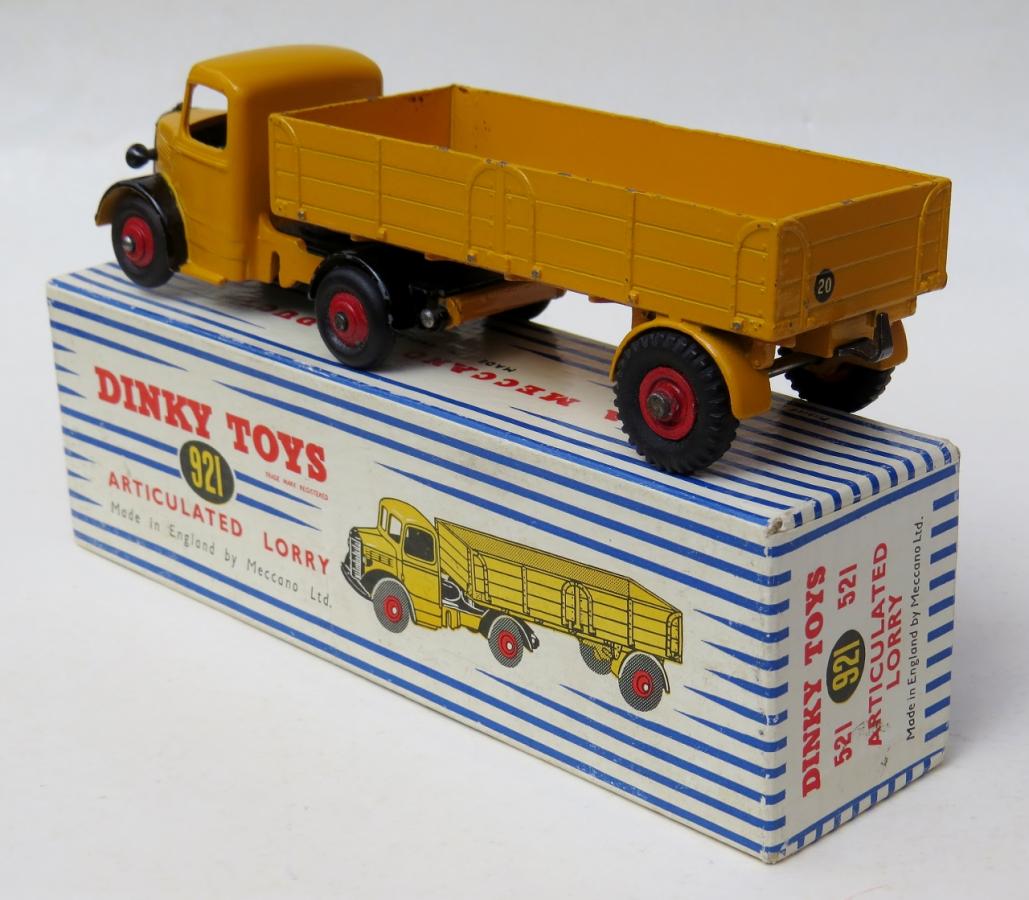
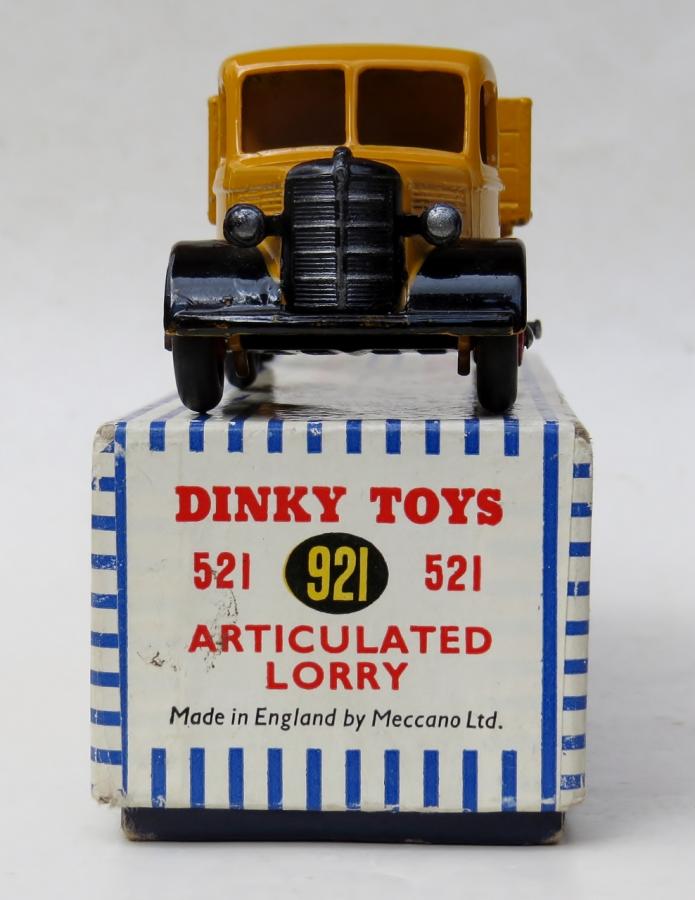



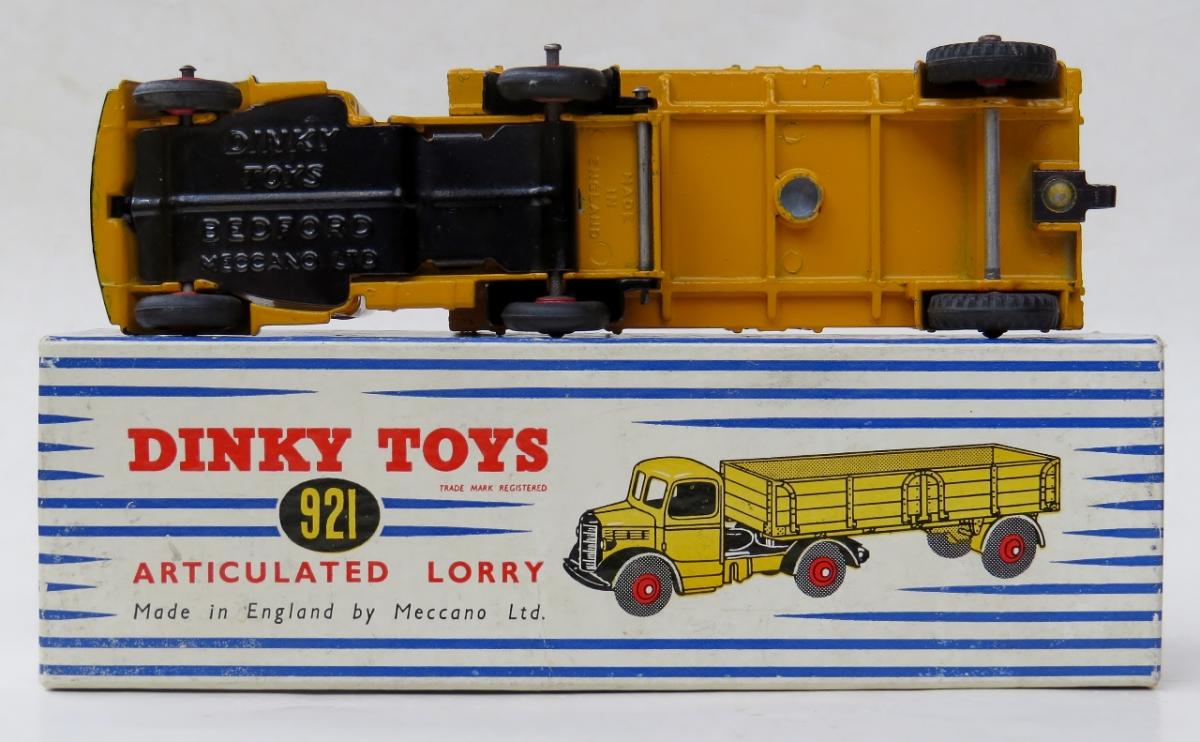
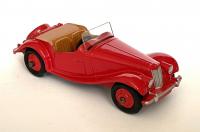
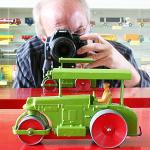

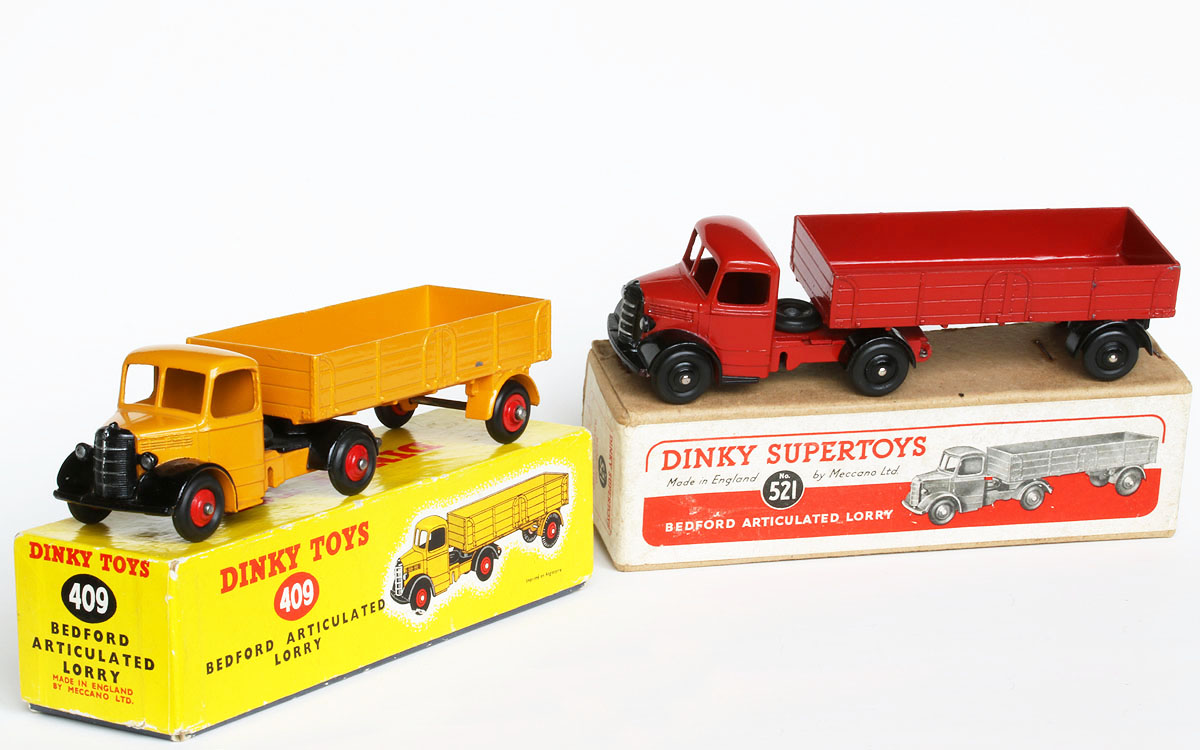



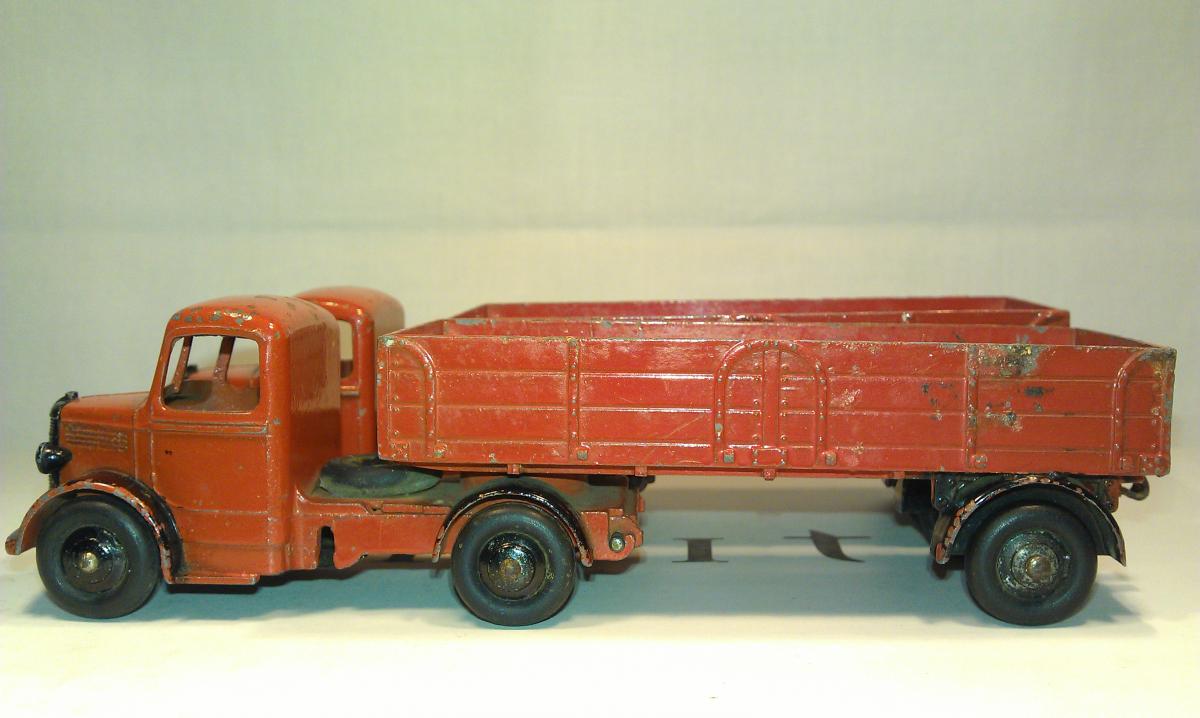


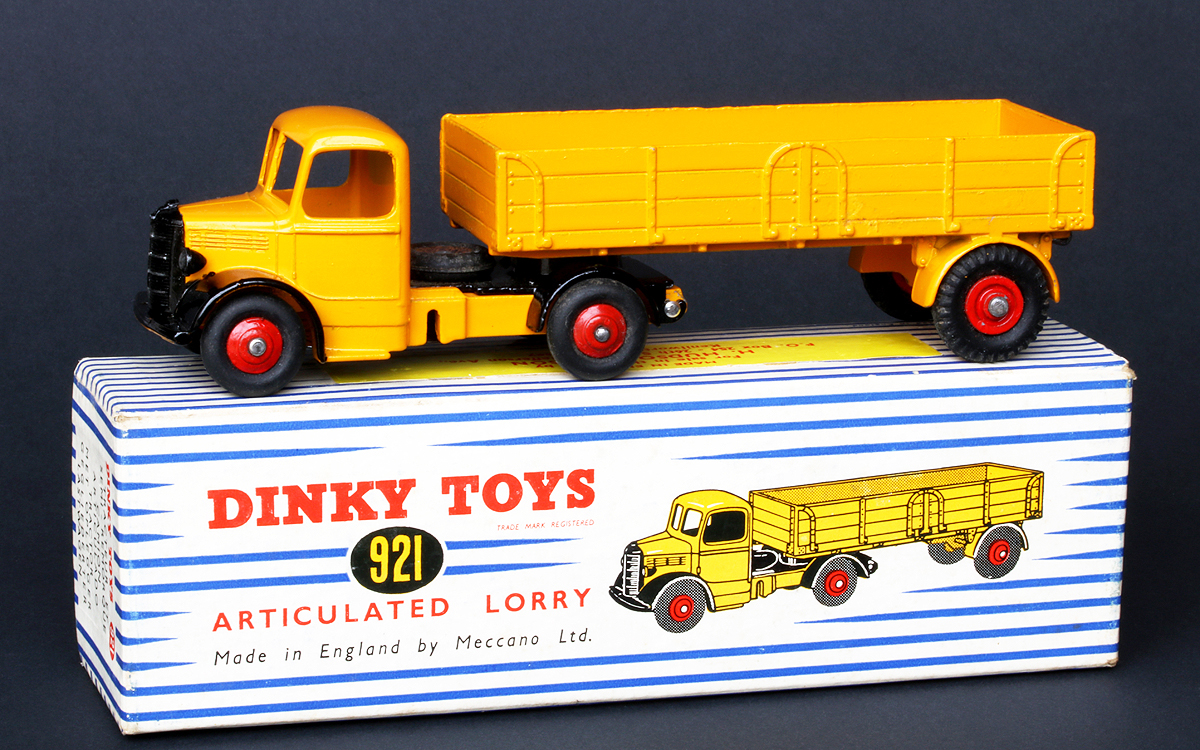
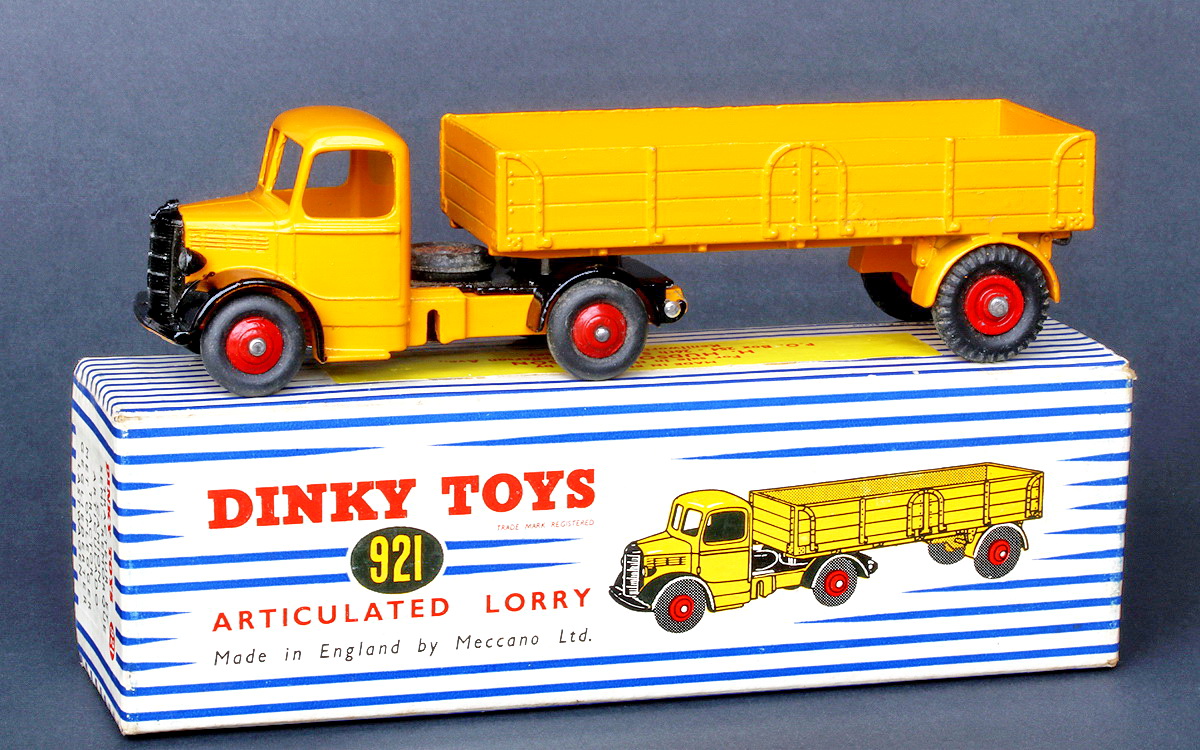
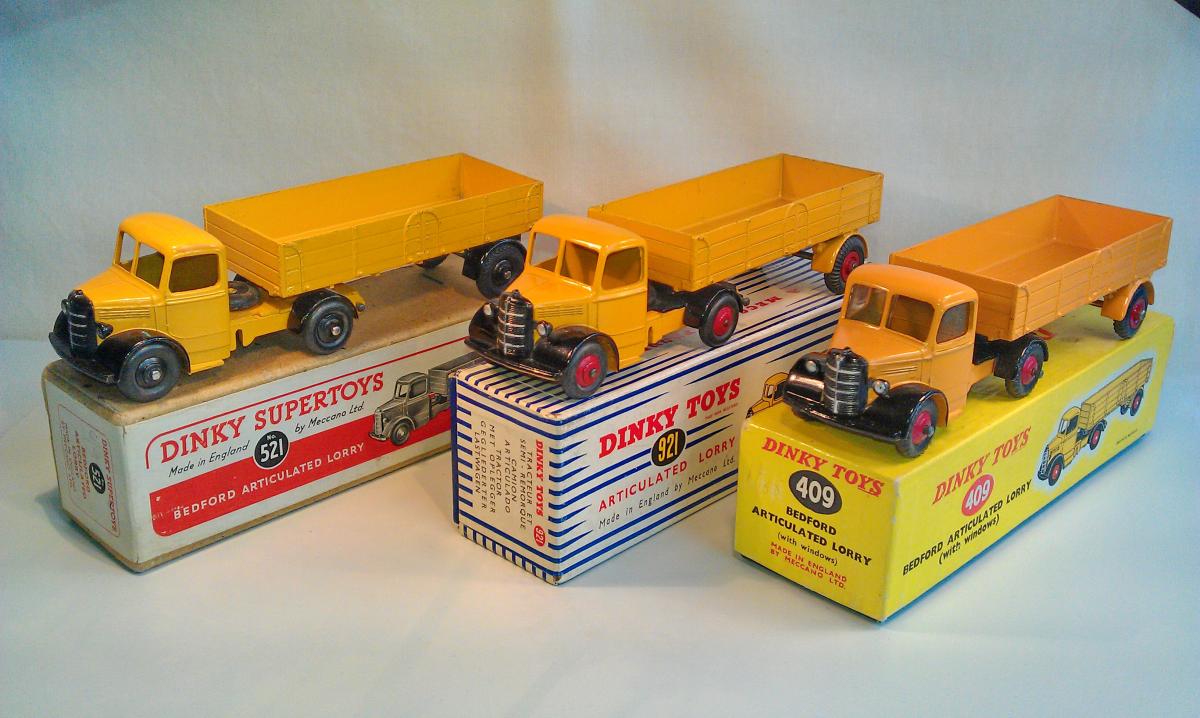

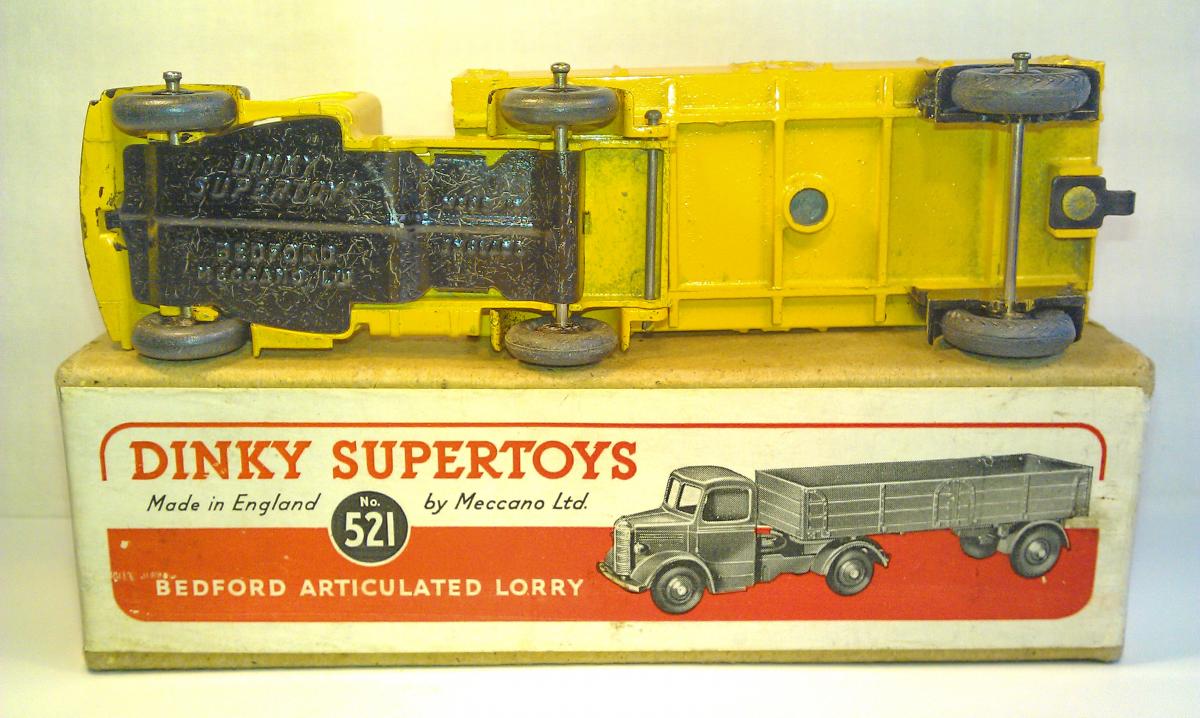
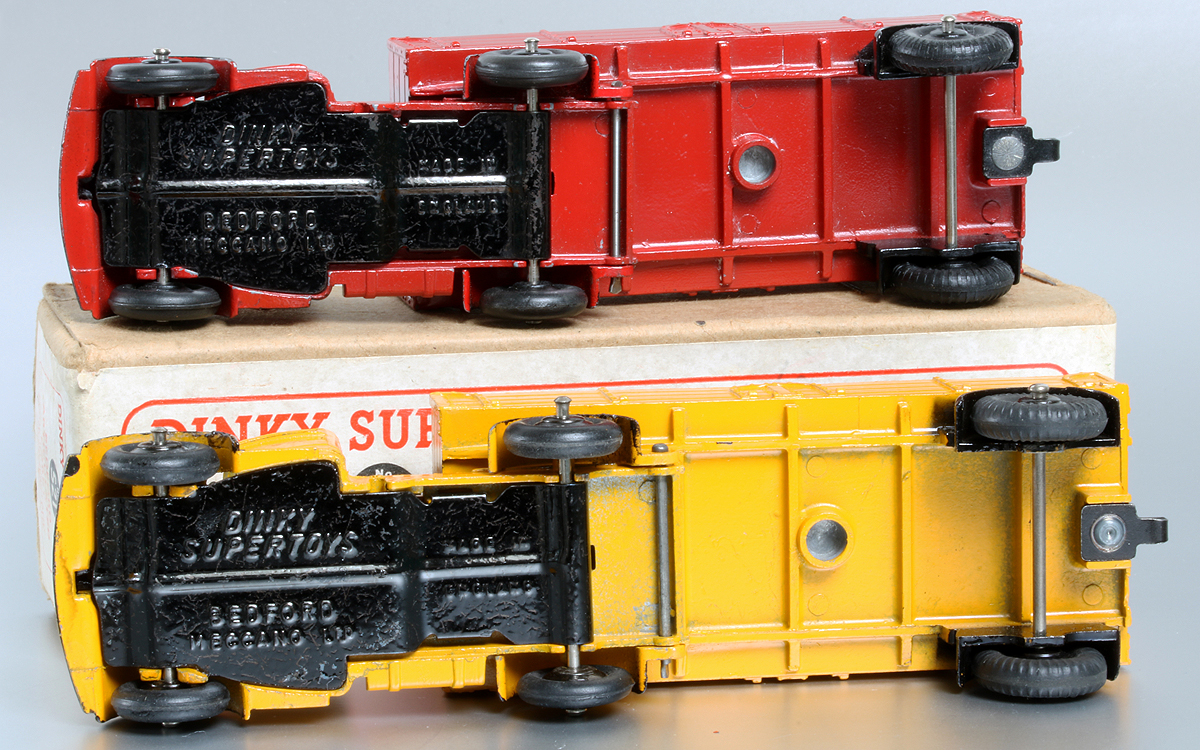

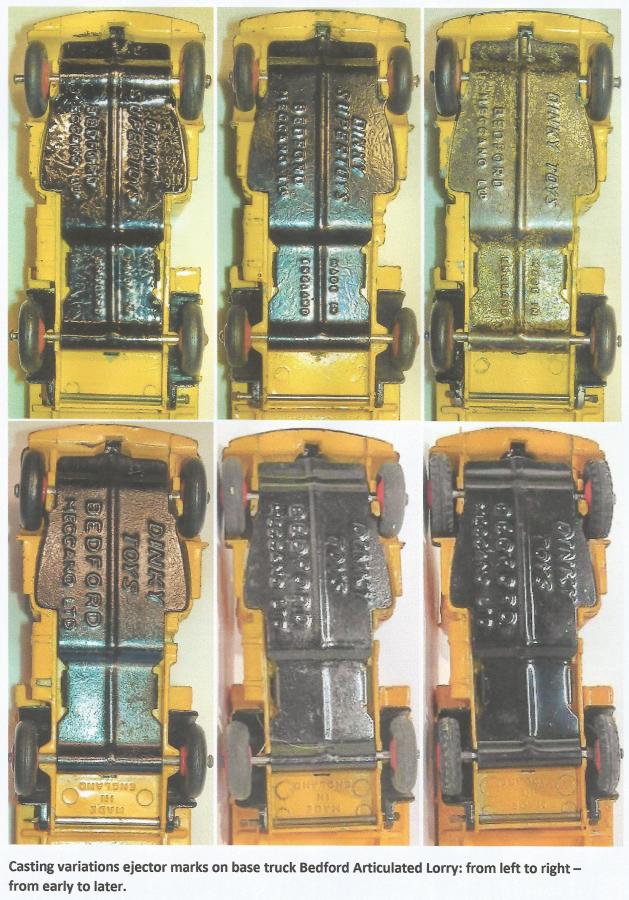



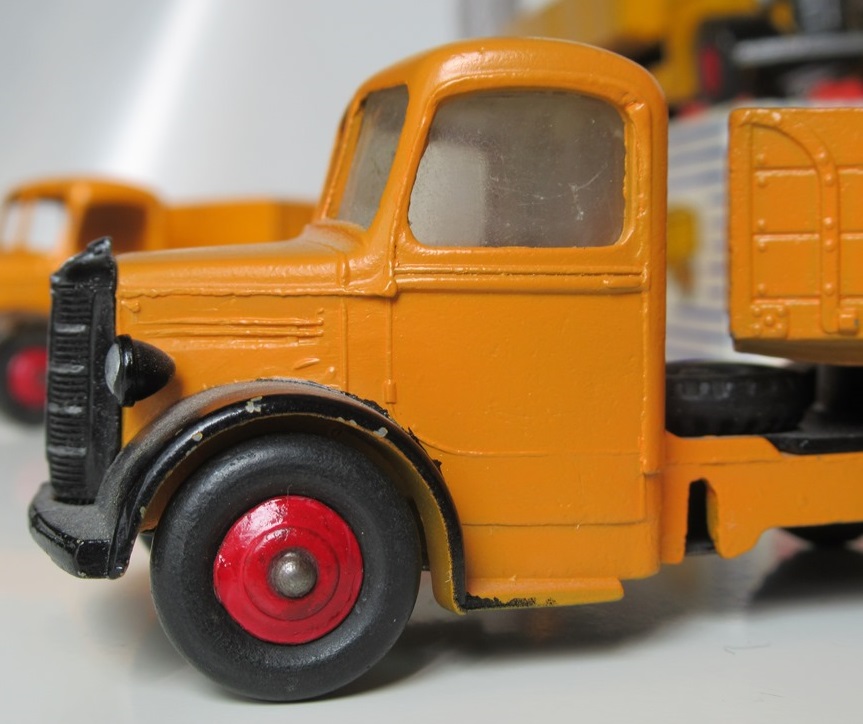
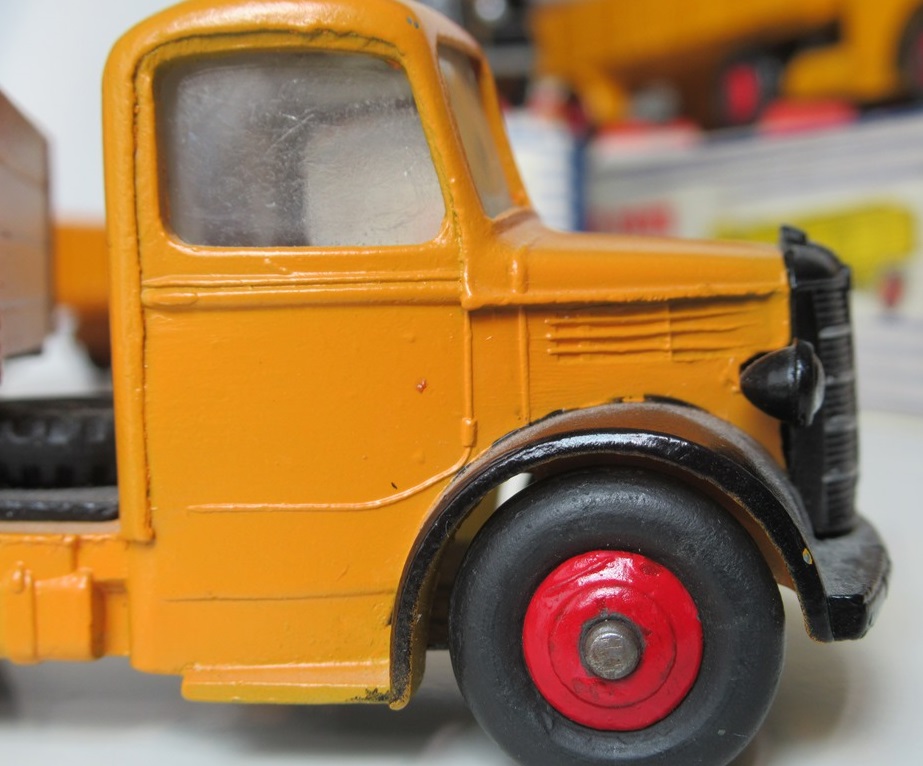
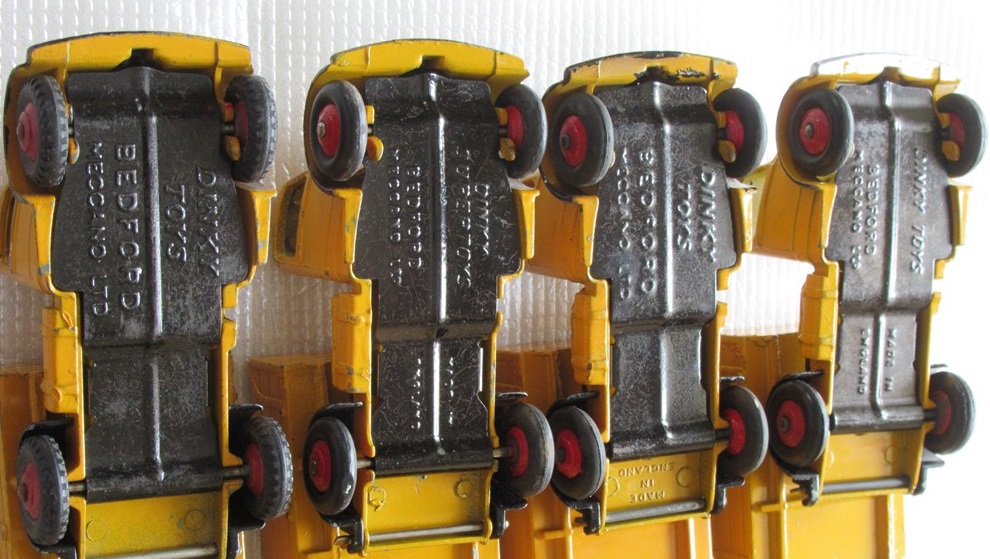
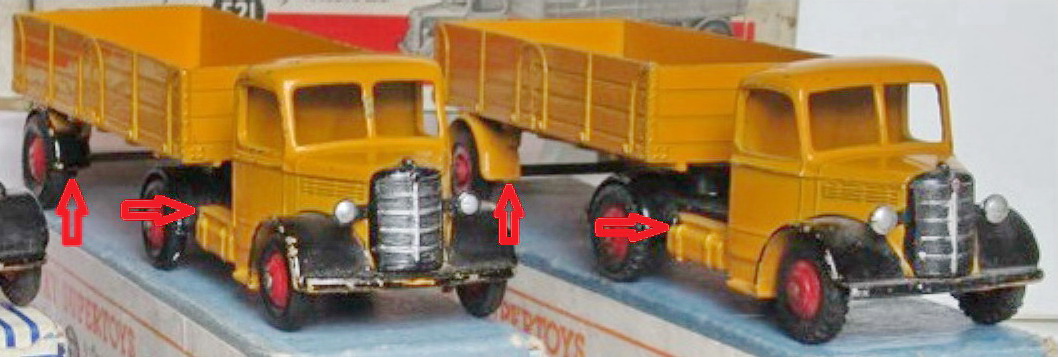
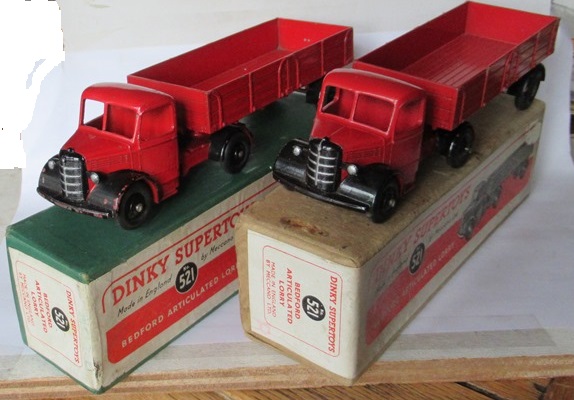
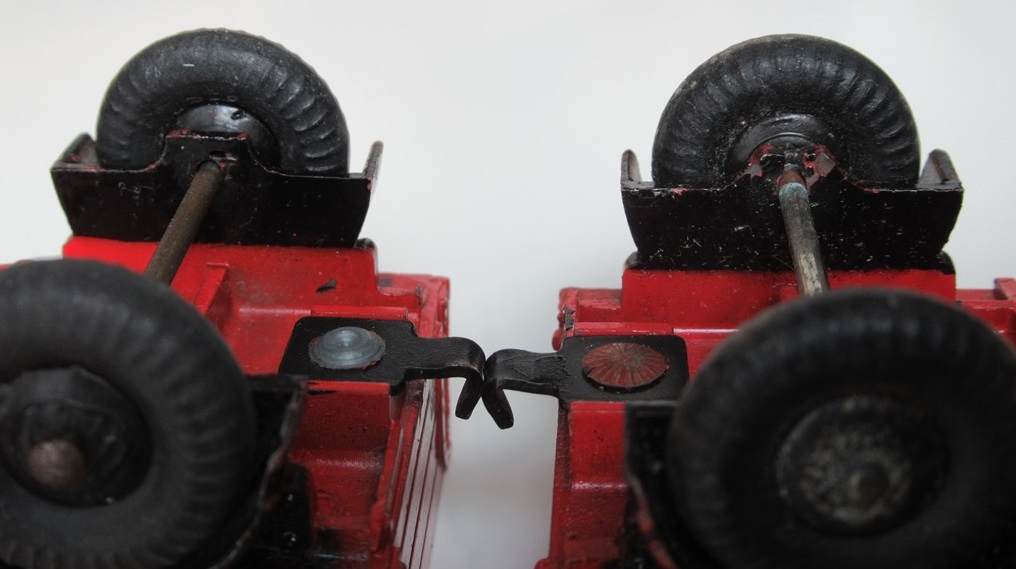
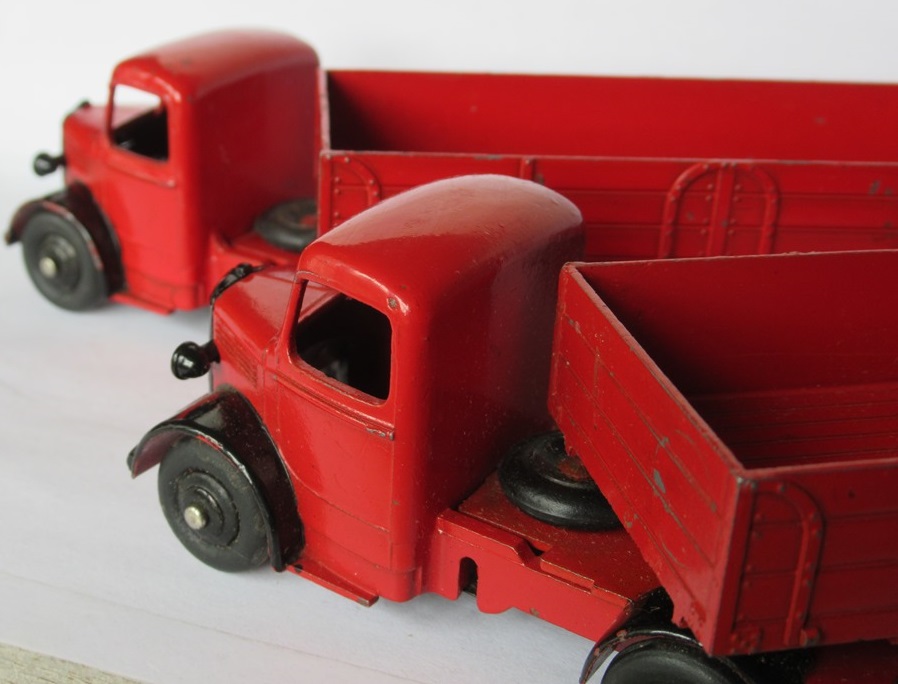
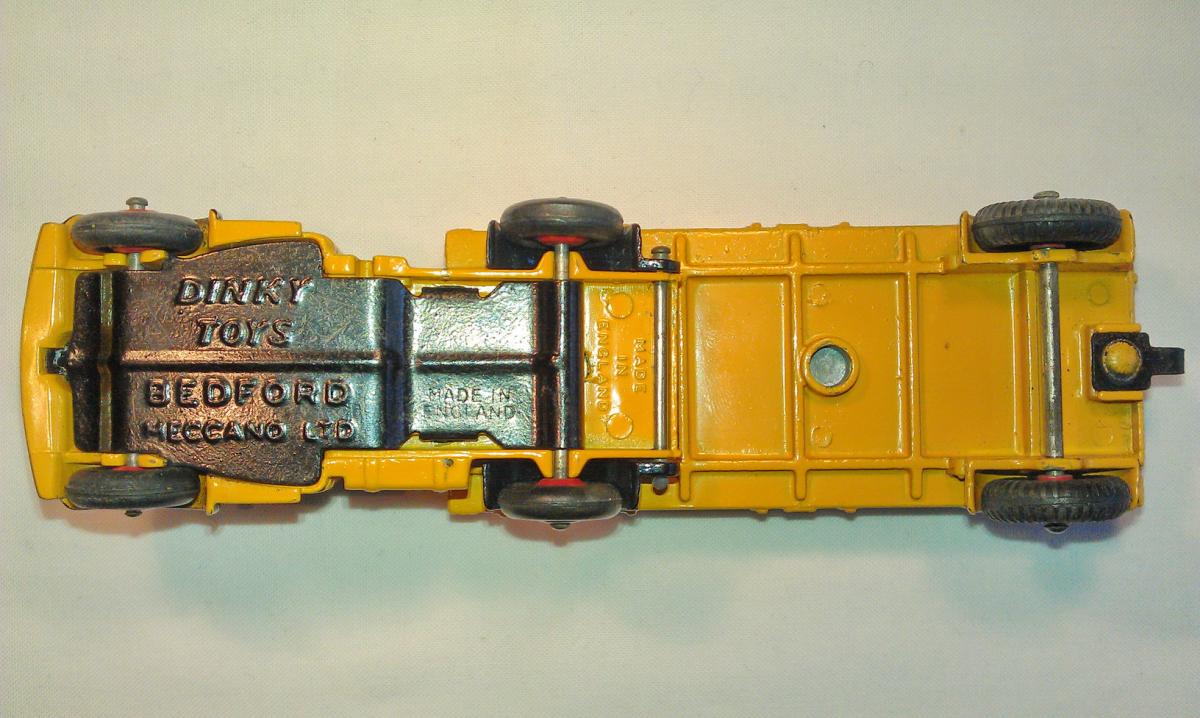


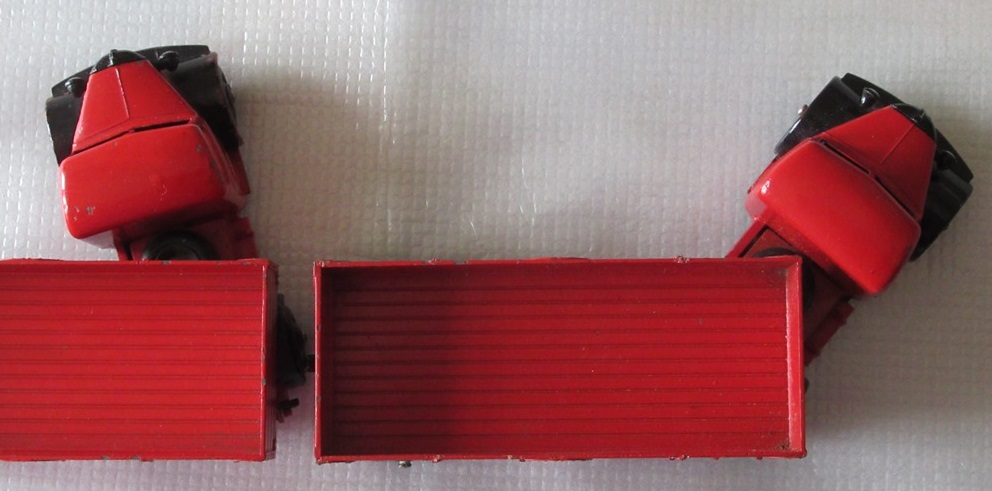
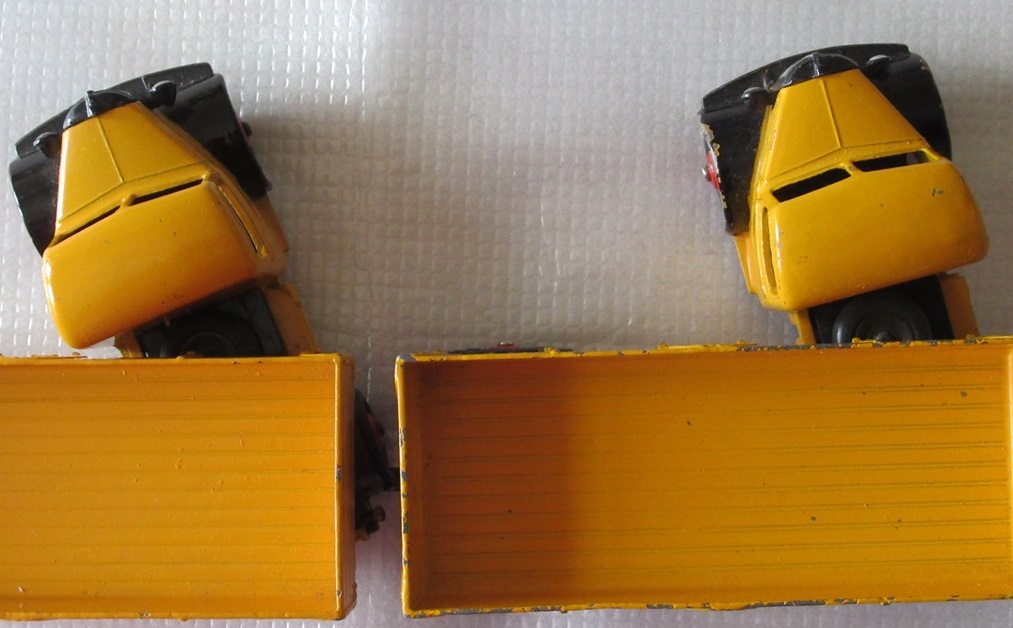

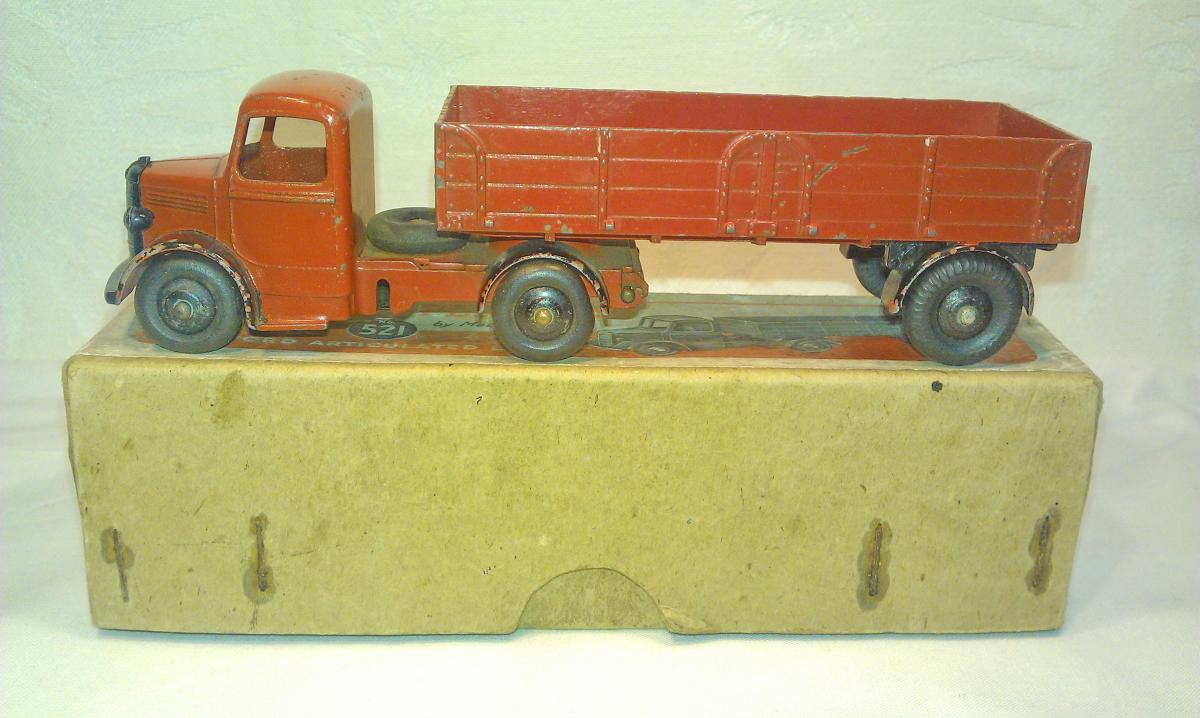
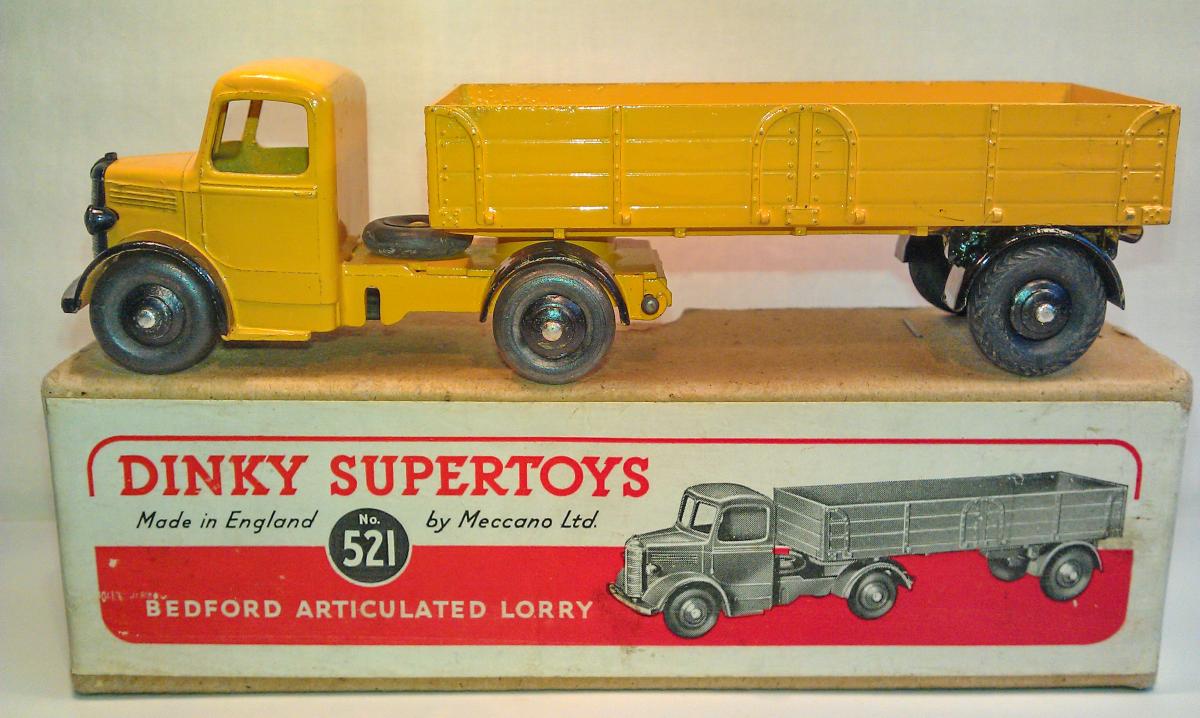
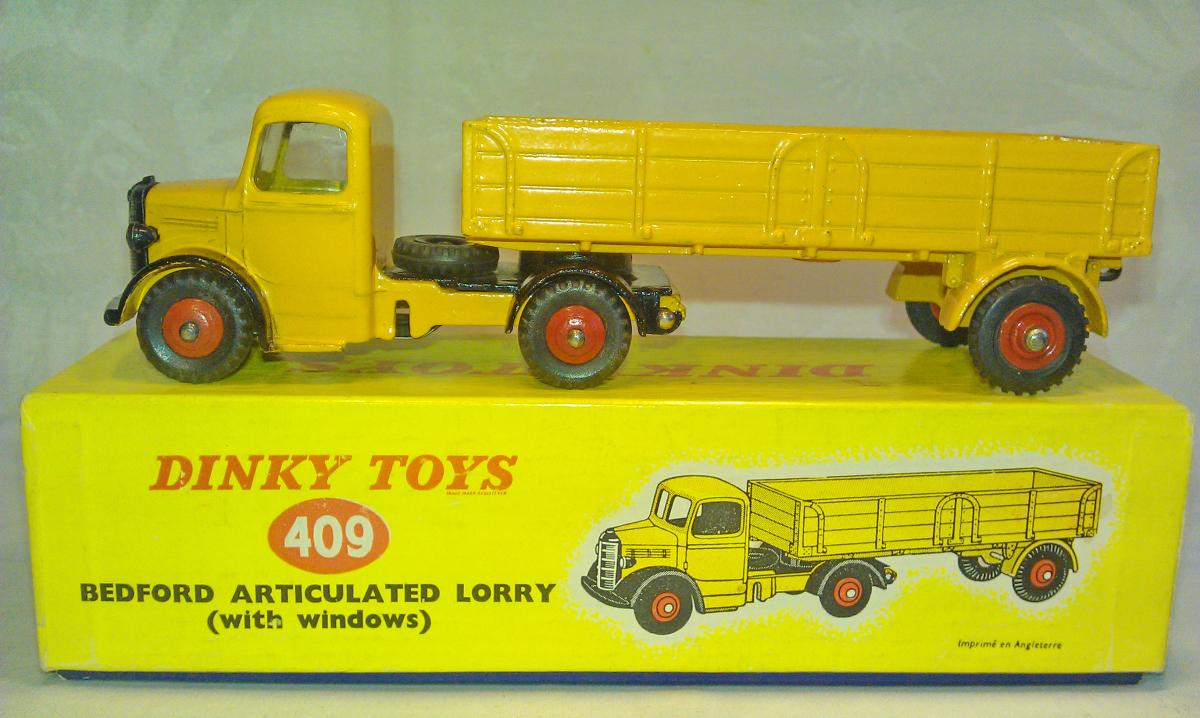

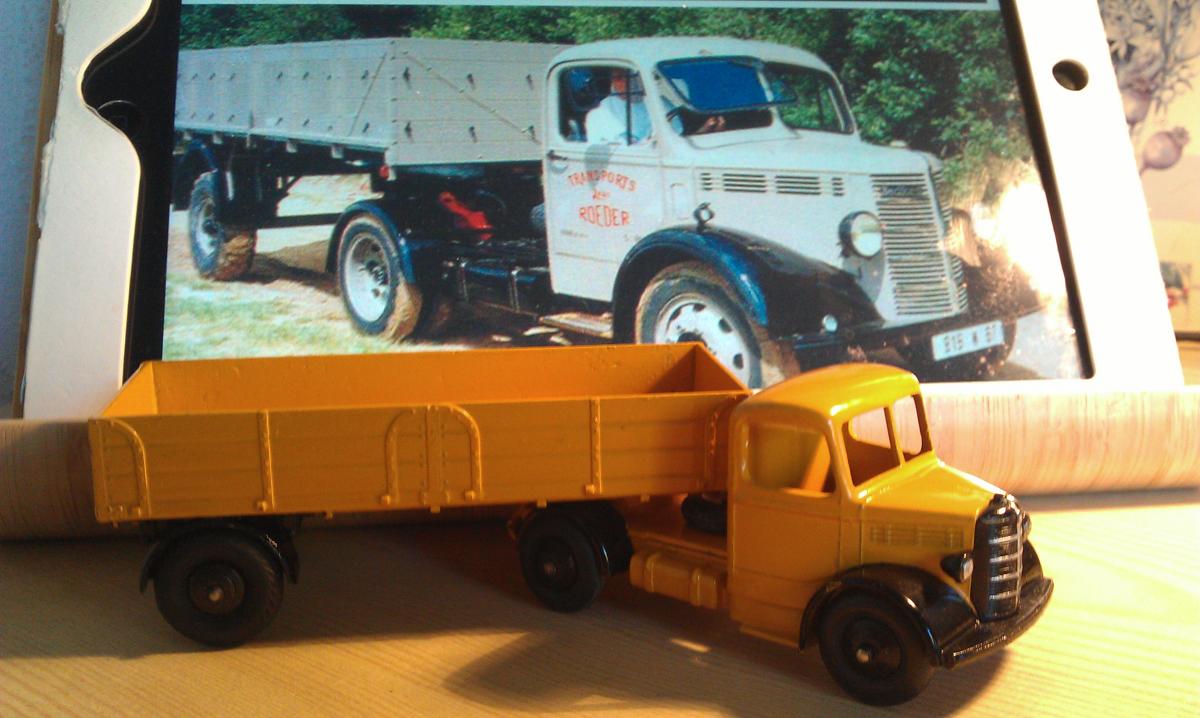
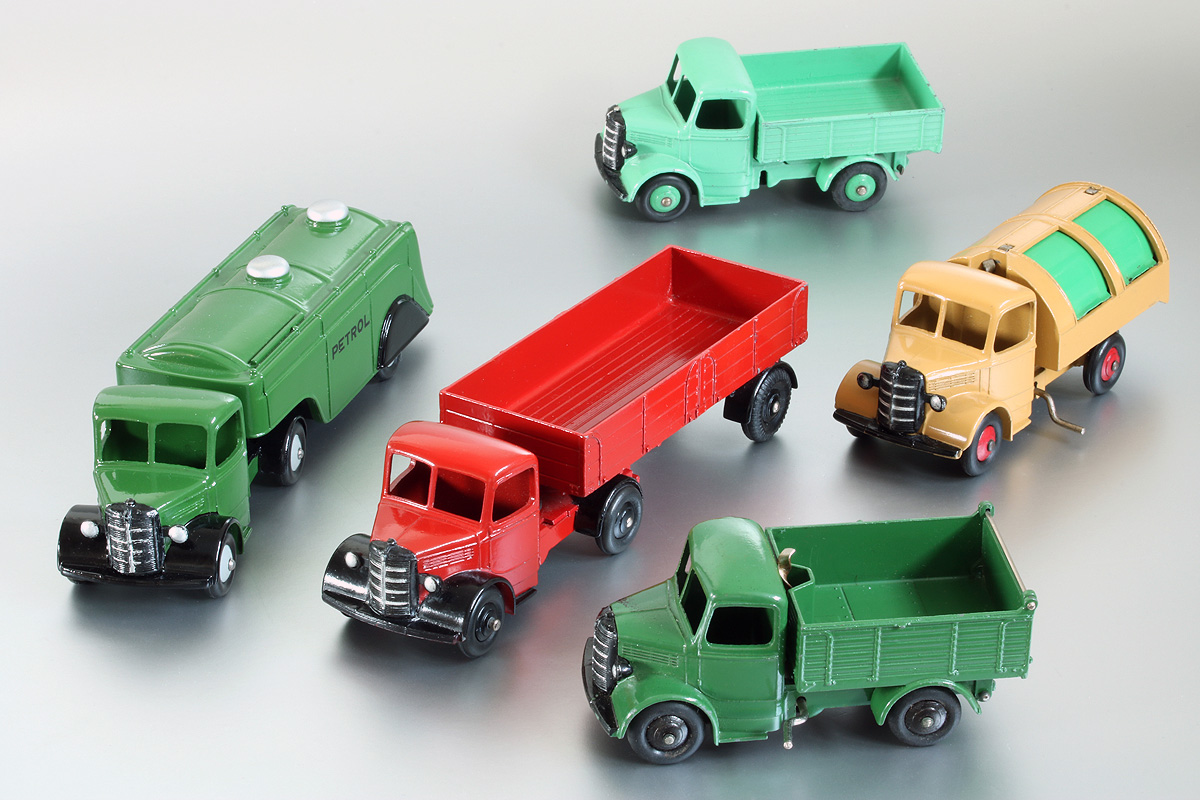

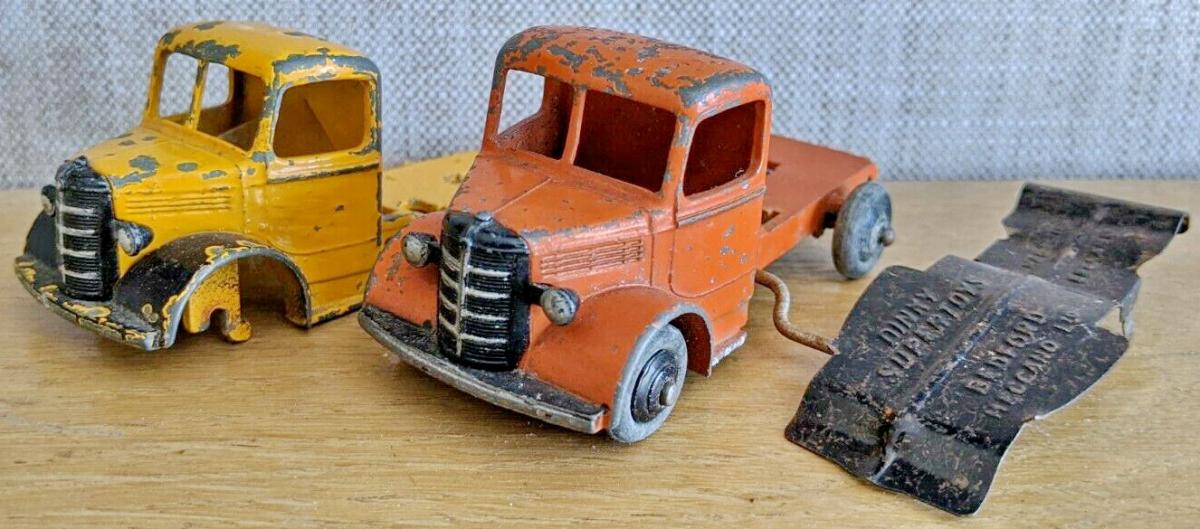

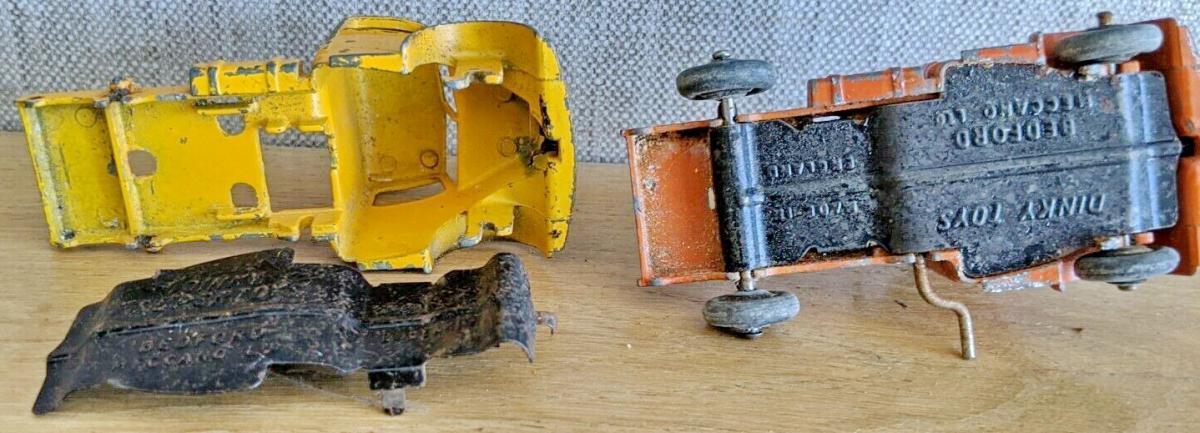
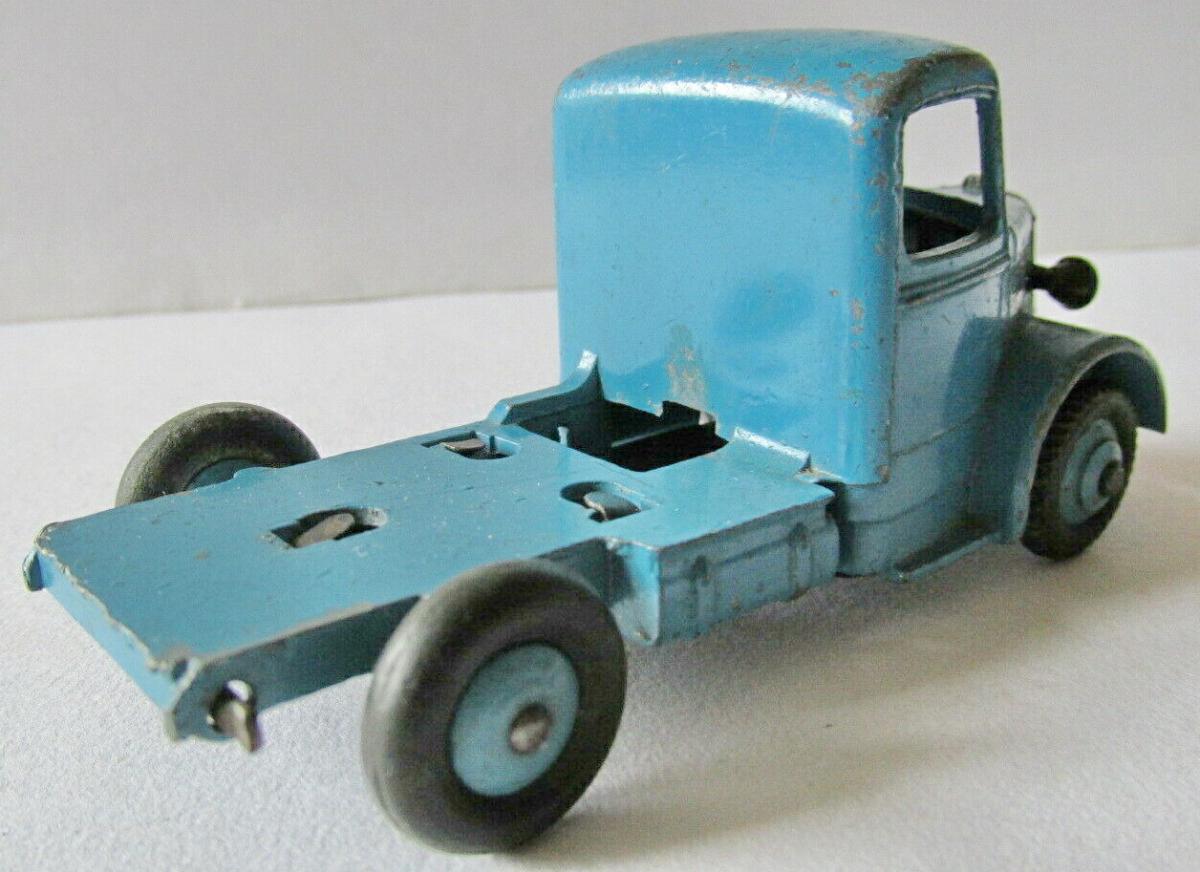
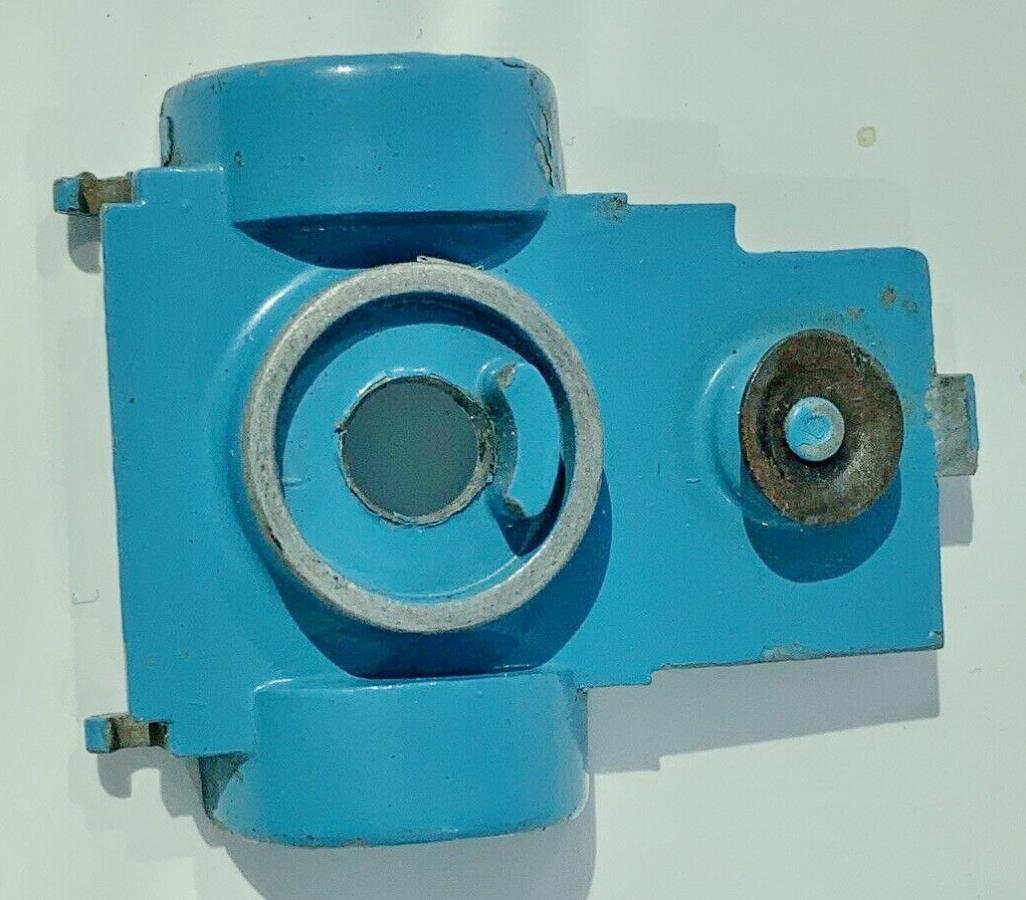
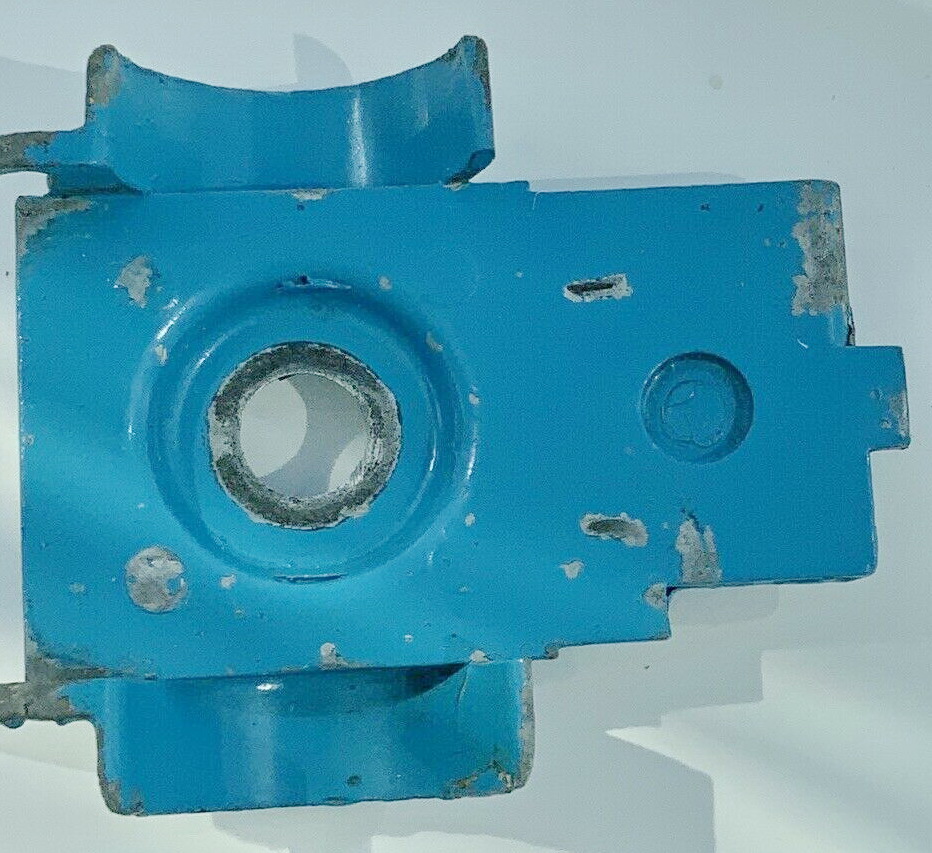


-914 AEC Articulated Lorry (1965-70)
-163 Bristol 450 Sports Coupé (1956-60)
-163 Bristol 450 Sports Coupé (1956-60)
-914 AEC Articulated Lorry (1965-70)
DTCAwebsite upgrade 2023
DTCAwebsite upgrade 2023
DTCAwebsite upgrade 2023
DTCAwebsite upgrade 2023
DTCAwebsite upgrade 2023
DTCAwebsite upgrade 2023
-508 DAF
--14c and 401Coventry Climax Fork Lift Truck (1949-64)
FRENCH DINKY TALBOT LAGO
-Boxes General Discussions including end flaps, both British and French
--14c and 401Coventry Climax Fork Lift Truck (1949-64)
--14c and 401Coventry Climax Fork Lift Truck (1949-64)
-508 DAF
DTCAwebsite upgrade 2023
DTCAwebsite upgrade 2023
DTCAwebsite upgrade 2023
DTCAwebsite upgrade 2023
DTCAwebsite upgrade 2023
-508 DAF
-508 DAF
-508 DAF
New arrivals
New arrivals
DTCAwebsite upgrade 2023
DTCAwebsite upgrade 2023
ORIGINAL MECCANO DINKY TOYS FACTORY BOX ART 175 HILLMAN MINX SALOON + DRAWING
--29c and 290 Double Decker Bus (1938-63)
DTCAwebsite upgrade 2023
DTCAwebsite upgrade 2023
DTCAwebsite upgrade 2023
DTCAwebsite upgrade 2023